Updated: 28 Dec 2016
The History of the Mersey Ferry
| Preface: There has been a ferry across the River Mersey for well over a thousand years. It is generally accepted that the first ferry was inaugurated by the Benedictine Monks of Birkenhead Priory. In fact, this is not completely accurate. There was a ferry in existence well before the Monks arrived. It ran from a stone slipway situated at Seacombe on an inlet on the northern side of Wallasey Pool close to where Kelvin Road meets Birkenhead Road today. In those days Seacombe consisted of a small collection of cottages that had no other reason for existence other than the ferry and is mentioned in the “Doomsday Book” of 1086. |
Birkenhead Priory |
| Popular locally is the belief that the monks of Birkenhead Priory in medieval times ran the only and first ferry 'cross the Mersey. It is likely that others also ran ferries 'cross the Mersey but were suppressed by the all powerful Prior who apparently would stop at nothing to maintain Priory dominance over local Lords and commoners. Birkenhead also had Ferries but we do not deal with those here. In my research the name "stoke" cropped up a few times, it confused the hell out of me at first, wondering why Stoke should figure so prominently in stories of the Mersey. The first mention of it involves the running of dispatches by William III from his military encampment on the Leasowes. Now I know it to be an area roughly where Seacombe Ferry is now. In 1396 there is a reference to Tokesford near Wallasey Pool, I imagine it to be the same region. |
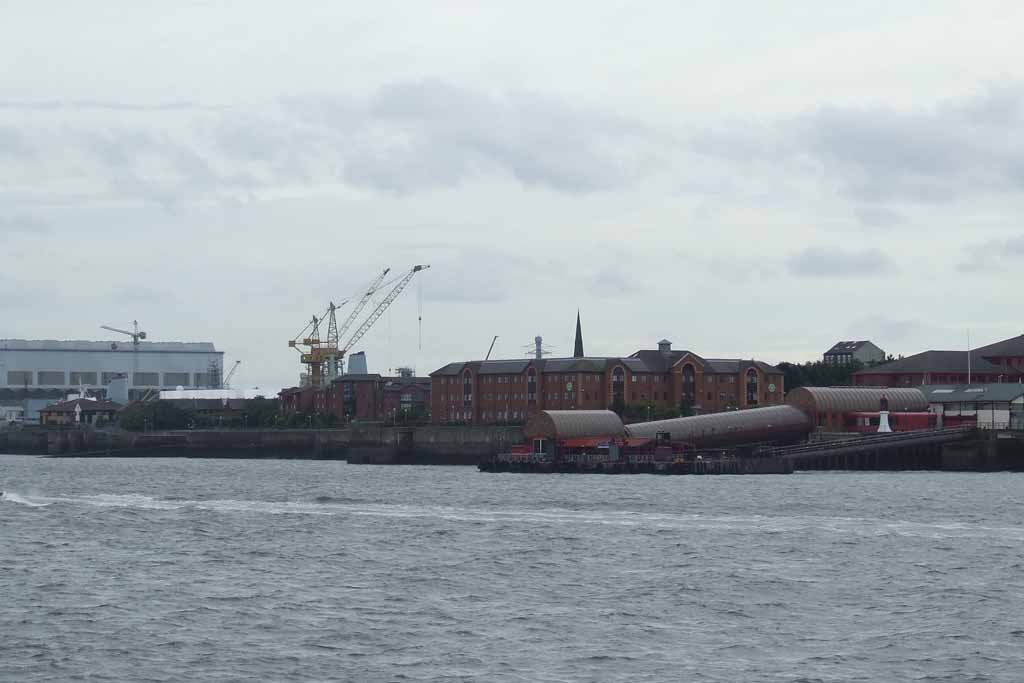 Monks Ferry is just past that inlet on the other side of Woodside Ferry (Image Sept 2007) |
| The abbot did not want his "nice little earner" being
spoilt by the possibly dozens of other entrepreneurs who plied the
river in small boats for a penny or two. They operated from a
site now marked by a small slipway, easily observed from the Ferry at
Woodside, about 50 yards upriver. "William de Lasceles, Richard
de Hough the Younger, Richard Sampson, John Corbyn, John &
William Hondessone of Secum, William Hondessone of Thornton, Gregory,
son of Robert of Secum and John de Clagton complained that Robert,
Prior of Birkenhead, and John Wodenot, Woodward had taken an anchor
and rope of theirs at the Mulnehowe, where they had no right to be. The Prior replied that he was the Lord of the Manor of Clagton in right of his church of St James of Birkenhead and he found plaintiffs with the anchor and chain, at the Mulhehowe, where they had no right to be. (It's seems clear to me that the Abbot recalled little of the incident as he said he took a chain, not a rope). Plaintiffs alleged that they were Lords of the Manor of Secum and, therefore, had the right of passage across the Mersee and could load and unload their boats at Waleysepull and between Waleyespull and Ranildspull either in Clagton or in Secum. This always had been the right of the men of Secum. The jury, naturally fearful for their souls, gave the verdict to the Prior and the Plaintiffs were fined thirteen shillings. I think this account is fairly indicative of the power the church held over the lords and the Commoners. Medieval Kings etc did nothing without the "blessing" of the church! |
|
|
There has been a ferry across the River
Mersey for well over a thousand years. It is generally accepted that the
first ferry was inaugurated by the Benedictine Monks of Birkenhead Priory.
In fact, this is not completely accurate. There was a ferry in existence
well before the Monks arrived. It ran from a stone slipway situated at
Seacombe on an inlet on the northern side of Wallasey Pool close to where
Kelvin Road meets Birkenhead Road today. In those days Seacombe consisted
of a small collection of cottages that had no other reason for existence
other than the ferry and is mentioned in the “Doomsday Book” of 1086.
This ferry may not have
been as regular or as reliable as the later Monks’ ferry was but it did
pre-date it by about one hundred years. Little documentary evidence is available concerning this ferry except for writings stating that the ferryman charged an exorbitant toll for the crossing and that it was not the most reliable of services. It is safe to assume that the ferry took the form of a rowing boat that carried the passengers across the “narrows” of the river to the vicinity of what was to later become St Nicholas’ Church. This ferry later became a “feeder” for the Monks’ Ferry. The later Monks Ferry used the same location as their Liverpool terminus, either because it already possessed a man-made landing stage or was a natural location that leant itself to the purpose. When the Monks’ Ferry was founded, the original Wallasey Ferry at Seacombe transported passengers to the Priory landing stage in order for them to ferried to Liverpool by the Monks. You can read more on the * Link at the bottom. In 1396 there is reference to a ferry which crossed Wallasey Pool at "the hooks" (now believed to be in the vicinity of Duke St Bridge). Thomas Lasselles and his family had been running this ferry from a time in the far distant past. Longer than anybody could recall at that time. This ran from Tokesford across the Pool. The name suggests that, at low tide, it was possible to ford the Pool and at high water, the ferry ran. These conditions existed until the Pool was built into dockland, being tidal. Again we have Birkenhead Priory interfering in time honoured traditions. They established a "new ferry" which later became known as "the ferry at the hooks", causing injury to the rights of the Lasselles. I presume the Lasselle family then "sank without trace" as there is no more mention of the family nor their long established ferry. Later, in 1552, proceedings were underway against the Lords of Tranmere (Yes, you've guessed it, by the Priory) alleging infringement of ferry rights. ("their" rights?). John Minshull, in reply, stated that his ferry was the ferry of Secum which has been leased by the Crown in 1541 to William Bromley, and from him to John Minshull. The result of the action is not recorded. It is generally thought that by listening to talk of Secum Ferry we should look to its present location, but in fact it could have been operating from Tranmere. The Lord of Tranmere was the "operator". Mentions of the ferry also occur in accounts dated 1626 and 1715. In the eighteenth century, 5 Ferry houses existed in Cheshire. Ince, Eastham, Rock (Rock Ferry), Woodside and Seacombe. In 1797 it was recorded that passengers were advised to make an arrangement with the ferryman beforehand and not pay until the return journey, when a boat would be hired to take them over. Regular passengers paid 2d, the wealthier 6d. Strangers were "imposed upon". |
|
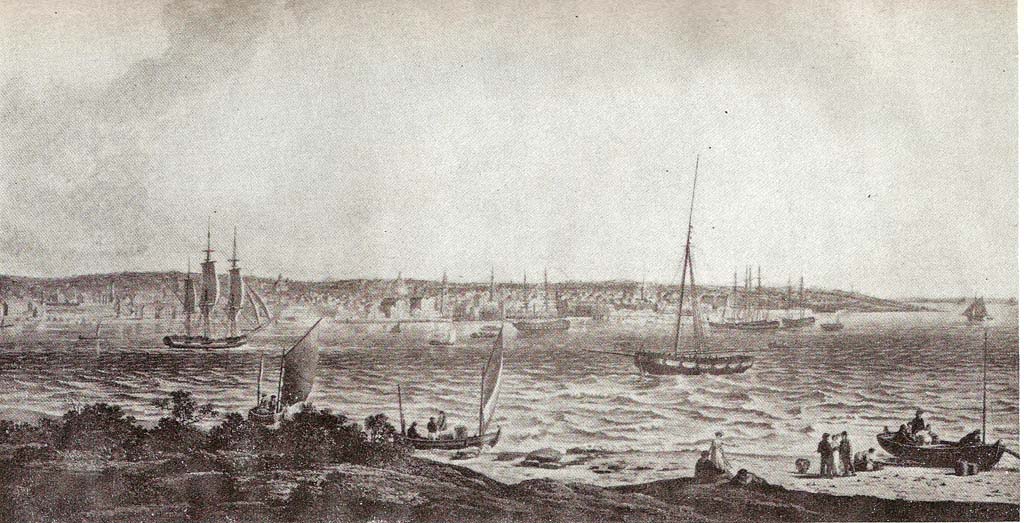 Seacombe Ferry 1817 |
1816 and ferry rights were the subject once again of a legal wrangle. The Rev James Mainwaring was in dispute with Mr Richard Smith with the latter winning his case and who, for many years, leased the ferry to Thomas Parry who ran it in conjunction with Parry's Seacombe Hotel and enjoyed a high reputation. (This hotel was later named Stoke's.) In 1823 there grew an argument between Sir John Tobin and one of the two Parry brothers, of Seacombe Ferry. It came to a personal level and legal action was taken. As a direct result of this, the Egremont Ferry came into being. Construction began in 1828. In an inquiry into Capt Askew's affairs (he operated Egremont ferry) it was revealed that he was not keeping to his agreement. The two steamers he owned to run on the ferry were being used to act as "tugs" to sailing vessels at the cost of £1 per tow. Passengers, stranded at Egremont ferry, complained. Out of this grew the Egremont Steam Ferry Company. |
| Advert in the Liverpool Mercury 30th April 1830: A boat will commence plying between Egremont Ferry and the Stair north side of the entrance into George's Basin, TOMORROW (Saturday) the 1st of May. The owner of the Ferry authorises me to state that as soon as the Hero is completed she will also ply. When that takes place the terms for ferrying will be announced, and the Public may depend on the strictest attention to the regulations. At the commencement the boat will leave every hour, beginning at Eight on the morning, and running until dark in the evening. |
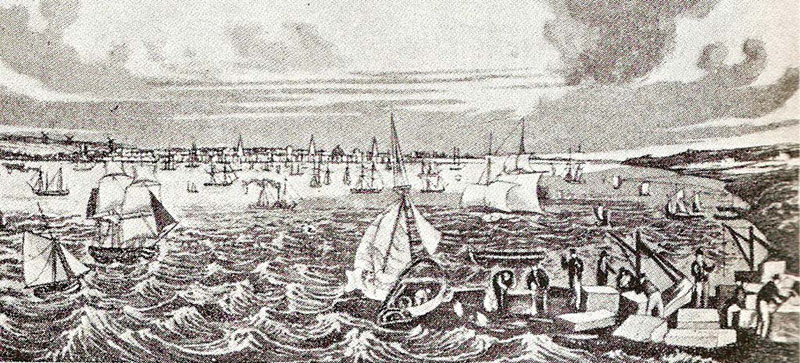 The building of Egremont Ferry after 1821 but before 1835 |
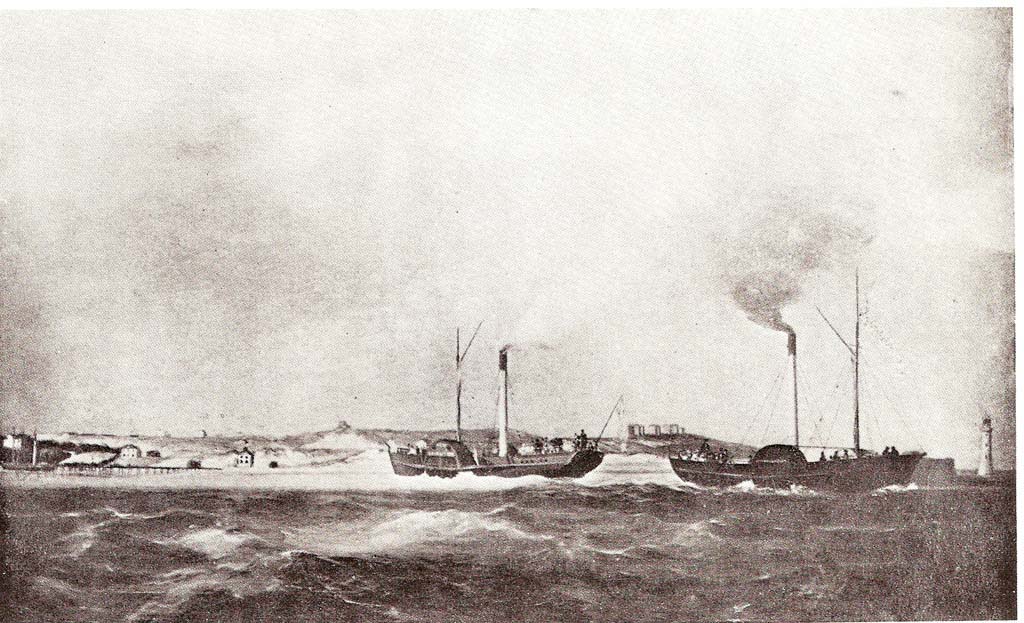 New Brighton 1835 |
Sometime
after 1835, but before 1843, a landing stage was constructed in
Brunswick Dock. It was for Seacombe steamers and was apparently
operated at the south end of Princes Dock. It was\described as
having an engine on the stage itself, the stage being on wheels,
running on lines laid on the top of the slip. In 1858 the engine was
moved to an engine house and from here the stage was hauled up this
slip to suit the level of the tide. By means of a chain it was
raised, lowering used the force of gravity (thank heavens for
Mr Newton!). Over at Seacombe, the landing stage was described in a
similar fashion but ran on rails by a mobile steam engine. Fare was
3d. In 1840 plans to introduce yet another ferry "Seabank Ferries" never got off the ground but, for some reason, it has a mention in the history of the Wallasey Ferries. |
Liverpool Mercury November 11 1841. Praiseworthy and Heroic ConductOn Saturday last, about five oclock, as one of the Woodside Ferry boats was about to leave the broad steps at George's Pierhead, a female who was rather late, missed her footing, and fell into the river. She immediately passed under the paddle wheel, was carried down the river by the ebb tide, and had disappeared twice under the water, when a gentleman of the name PIKE divested himself of his coat, and in the most heroic manner leaped from the stern of the vessel to her rescue. Being an excellent swimmer, he soon reached his object, whom he caught, and a small boat pushed off, reaching the parties in time to save both. We believe the gentleman has not suffered from his manly and generous efforts, and we are gratified to learn that a subscription, not exceeding one shilling, has been commenced at Woodside, for the purpose of presenting Mr PIKE with a small token of the admiration in which his conduct is held high by his friends and the public. |
In
1845 it is recorded that a Mary Sharples ran both the Egremont Ferry and the
Egremont Hotel. In 1847 a John Fletcher, of Toxteth Park, Liverpool
purchased the lease. In 1850 the Coulbourn Brothers owned it who then
sold it to the Council in 1860!
Mr Edward Warburton Coulbourn bought Egremont & New Brighton Ferries in 1850 and managed them both for some time. His brother William Rushton Coulbourn joining the venture in 1859. In 1857 the Woodside was involved in a collision with the Fairy and began to fill quite rapidly. Passengers were transferred to the Tiger and the Woodside moved as far as Princes Basin where it sank. |
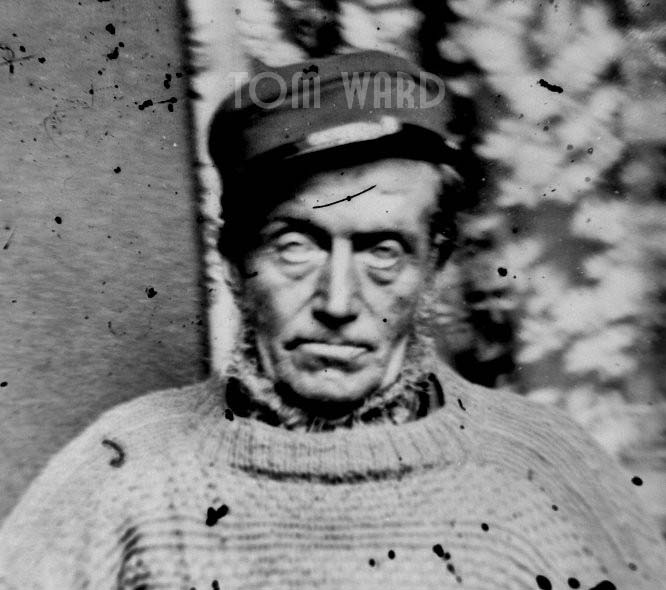
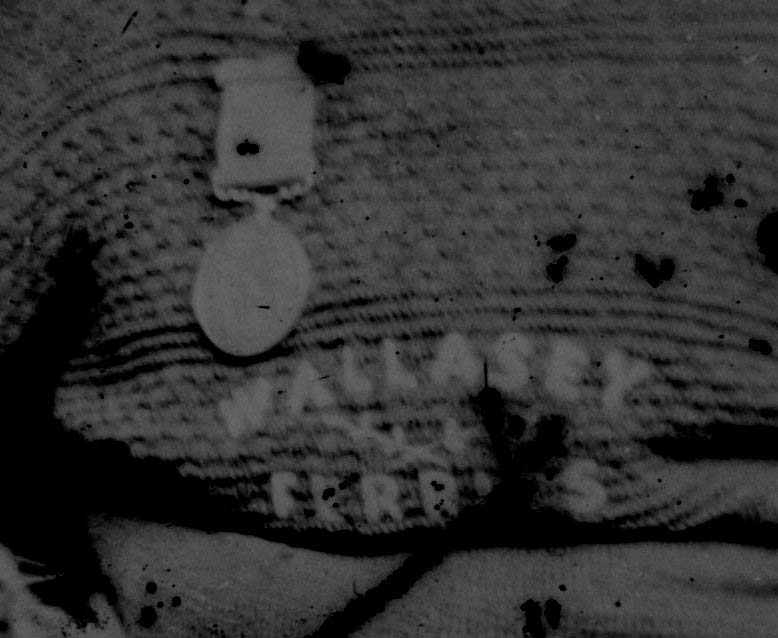 |
Wallasey Ferry Committees Minute Book 1858-1865
10 Feb 1864 - The Committee had been notified that their ferry crews were going on strike at the end of Jan. At first Woodside Ferry was to provide one of their ferries and a crew to cover the Seacombe to Liverpool service but the Woodside crewmen wouldn’t do it. The Chairman and Manager of the Wallasey Committee therefore chartered the steam tug Despatch with her crew at 11 guineas per day of 12 hrs duration. The tug commenced service at noon on Fri 29 Jan and ran the service till the Sunday evening.
10 March 1864 – Certain repairs had become necessary to the ferry
Mayflower. The Manager was authorised by the Committee to charter
some suitable steamers whilst the Mayflower was undergoing repairs.
17 March 1864 – The Chairman reported that one of the old tug boats,
with her crew, had been chartered at 11 guineas per day of 12 hours.
|
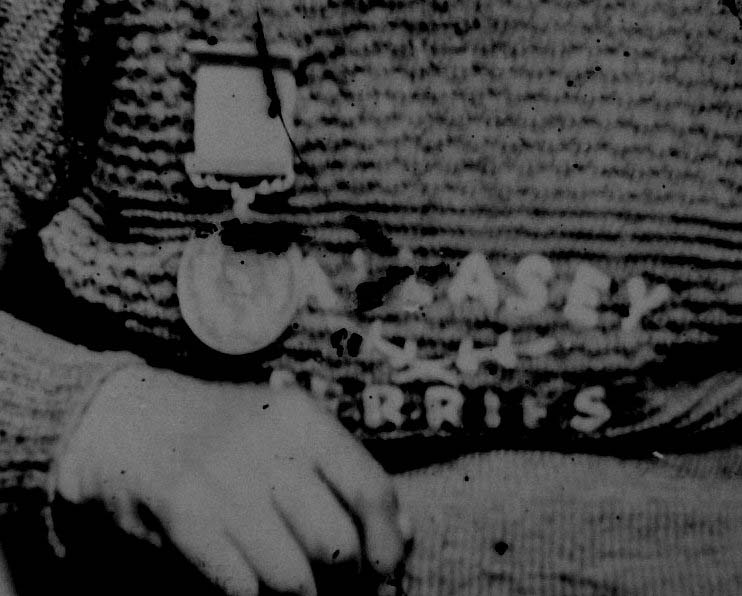 |
Wallasey Ferry Committees
Minute Book 1858-1865 15 May 1860 – It was resolved at this meeting that during the period that must elapse before new boats can be built the Board should either charter boats or purchase existing vessels with a view to re-sale. 17 April 1862 – At a meeting of the Ferry Committee today the Manager provided an update on discussions with Messrs Forrestor & Co re constructing new steamers. He further reported that he had made arrangements with Messrs Cruse and Downham for the use of the ferry steamer Hercules on Good Friday on payment of £14. (My note: Hercules was a tug not a ferry as referred to in the minutes. Cruse and Downham had Lairds build it in 1861 for their company – the Hercules Steam Tug Company. I’ve seen the spec and the contract so I know it wasn’t a ferry.) - Julie Holland. |
| May 2010: At
this point I interrupt the history to insert some images (above) (from plates) sent to me
by Tom Ward dated around 1860.
They show a Wallasey Ferryman with a medal. Tom Ward tells me:
I suspect the medal
might be the 'The Marine Medal' of the Liverpool Shipwreck and Humane Society.
The photos seem to be the work of
William Wilkinson of 103 Park Road, Liverpool & Victoria Road, New Brighton and
appear to date from the 1860/70's. (I wonder if it could be something to do with the incident of 1857 mentioned above?) Also an email from Paul McBreen who says: I noticed the break in your story to include the new addition of someone with medals from the Society and wondered if it might be our relative , Captain John Pugh. It’s possible as their were only 5 or 6 captains on the books of the Corporation during the 1860’s. |
1863. The Liverpool and Birkenhead Ferry-Steamer, 'Cheshire', was launched 31st
October 1863. This paddle-steamer ferry was built for the Woodside Ferry
Commissioners to a design that allowed up to 2000 passengers per journey.
Unusually, the 'Cheshire' was launched with her boilers already fired up and set
off on a trial-trip down the Mersey straight away. She was a twin funnelled
paddle boat not too different from the Heatherbell (see
vessels). In Nov 1865 the Confederate warship Shenandoah arrived in the Mersey to surrender to the British Navy. The ship caused quite a stir and ferry boats were used to take people out and around her, moored in the river, off Rock Ferry. |
| When William Carson assumed the role of Ferries Manager, he took it upon himself to design an iron pier for New Brighton with the first floating landing stage. Whilst this was under construction, in 1865, a ship, the Lamport & Holt's "Galileo" ran into it. The helmsman had apparently misheard "larboard" for "starboard" and, also did not query the order. Weather conditions at the time are unrecorded. The Pier was eventually opened in 1867. In 1874 Carson designed and had built the Egremont pier. | |
|
From Dave Jones: FROM THE WALLASEY PARISH MAGAZINE, JULY 1875 THE NEW SEACOMBE FERRY. We have the pleasure to inform our readers that all difficulties with the government departments are overcome; the necessary consents have been obtained, and the work of constructing the new ferry at Seacombe is to be proceeded with at once. The arrangements with the landowners whose interests would be affected by the alterations in the approach‑roads have also been completed, and the whole scheme is therefore fairly afloat. The importance of this work cannot be overrated; Seacombe ferry is the key and highroad into the parish, and the parish will expect that with so many similar works around them the Local Board will profit to the fullest extent by the experience of their neighbours, and render the new ferry the most complete and convenient one on the Mersey. We make no doubt but that this will be so, and we propose to describe the general design so that the parishioners may be able to judge of it for themselves. The first step to be taken is the construction of a river wall in a line from Seacombe point to the shipbuilding yards, and the reclamation and filling up of the foreshore at the back of it to the end of Dock road. A part of this space, next the shipyards, is to be taken by the Dock Board; the middle part is to be devoted to the station and approach‑road to the ferry, and the northernmost portions will be given over to the landlords whose property it fronts. Each will pay their proportion of the cost of the wall and the filling up. The next step is the placing of a floating landing‑stage in deep water, or at a distance of about 230 feet from the front of that part of the wall which bounds the Local Board's plot. This landing‑stage will be of similar construction to the others in the port, and does not need further description than that it is to be some 350 feet long and 70 feet broad, or about three‑fourths of the length and nearly the breadth of the old George's stage, an ample space for the accommodation of coming generations of parishioners. The access to the landing‑stage will be by means of two bridges and a high level pier. The northern bridge is to be the passenger approach, while the southern bridge and the high level pier, midway between them, will be used, as may be most convenient, for cargo and cattle. At the shore end of the passenger bridge the passenger station will be constructed. It is to contain the turnstiles, and the necessary waiting and retiring rooms, parcel and other offices, for the conduct of the passenger traffic. A projecting roof in front will afford a dry set‑down from vehicles, the bridge will be covered over similarly to that at Woodside, and a roof will also cover the passenger end of the landing‑stage; so that an absolutely dry roadway will be provided right up to the ferry boat. So much for the passenger accommodation, which appears to us to promise more convenience than at present exist elsewhere on the river.We now come to the arrangements for the goods traffic. As already stated the south bridge will be used for this traffic, and it will be very convenient for about four or five hours at high water time; but at other times its inclination will prevent its use for all but light goods and cattle. contijnued right >>
|
A means of carrying on a continuous traffic had therefore to be devised, and the Local Board purpose to construct the high level pier to satisfy this requirement. The pier will be constructed level with Dock road, and will run nearly as far into the river as the landing stage. At the end of it and within the piers which will support it, two hydraulic lifts are to be placed; their platforms will be a continuation of the pier roadway when fully up, and they will be raised or lowered to the level of the deck of the landing stage with goods, cattle, or wheeled traffic upon them, when it is desired to make a communication with the ferry boats. In the same way if a loaded cart, for example, comes off the ferry boat, one of the lift platforms is brought down to the level of the landing‑stage, the cart and horse are driven on to it, and both are then raised to the pier overhead, when the cart will be driven off and the platform is ready for a return load to the boat. The power which is to move these lifts will be able to raise a load of 25 tons at one operation; the Board believe they can in time arrange for the conveyance of loaded railway wagons across the river, thus forming a junction between the dock lines of railway on both sides of the Mersey, and they will provide sufficient power in the hydraulic lifts for raising the heaviest railway wagons with their loads from the landing‑stage to the pier and vice versa. For this purpose also the dock rails' are to be continued on to the pier and landing‑stage, with turntables, hydraulic capstans, and other appliances suitable for working such a traffic. At first the railway line will only be used for conveying coal wagons to the ferry steamers for their supply, but it is confidently expected that this traffic will develop by the provision of a similar means of discharge on the Liverpool side; and the wagons would then be carried by suitable ferry‑boats from one side of the river to the other. Covering the ground between the passenger station and the cargo bridge, a goods station is to be erected with stores, offices, weighing machines and other matters necessary for the large traffic which will, no doubt, develop itself in time.. Having got our passengers or our goods on terra firma we proceed to show how they are to get into the parish or to the docks, as their destination may happen to be. The passenger bridge will be directly in line with Church Road, which is to be carried down to the river; and if our readers will now imagine the hotel and the houses up to this line to be all cleared away, and their sites formed into an open PLACE extending right up to the parish slip on the south, and to the new line of the river wall in front, they will have before them the magnificent approach, some 200 feet wide, which the new ferry will possess. Church Road will thus be made the main line of communication with the parish, and it is to be widened to 60 feet. Victoria Road will also be made 60 feet wide from Demean Street, and will be lowered gradually from that point, so as to meet the Dock Road on the level; thus abolishing the objectionable hill which now interferes with traffic round the hotel corner. By arrangement with the landowners the high ground upon which the bowling green now stands is to be levelled for building, from Victoria Road down to the new ferry, and upon the site so formed, the future business part of Seacombe will no doubt arise in consequence of its proximity to the ferry. We hope it may be worthy of so fine a situation. In conclusion we congratulate the parishioners upon the Local Board's adoption of so grand a scheme. We hope it may be carried out in its entirety, and we feel sure that every penny so spent will bring in a large return. |
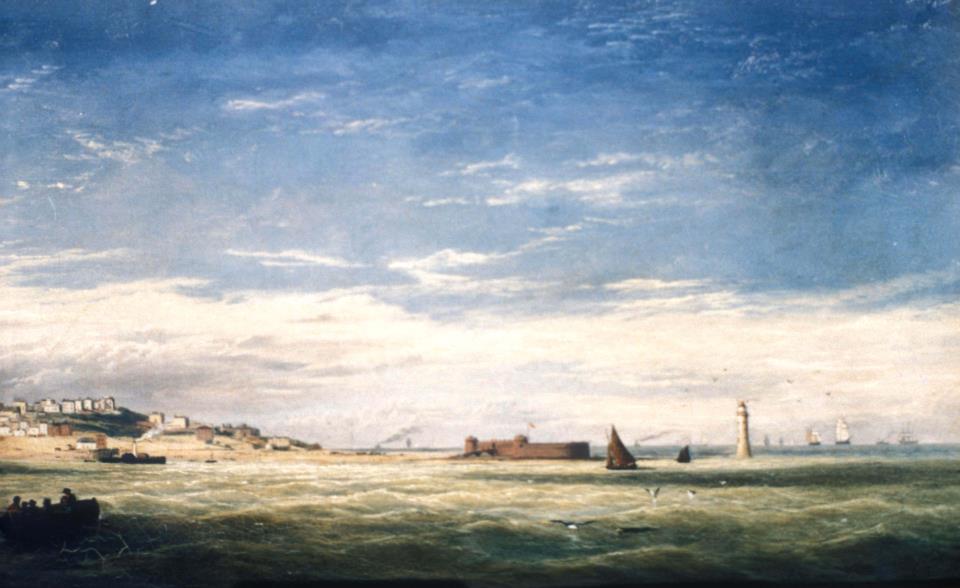 New Brighton 1855 |
By 1876 Seacombe Ferry carried annually some 1 3/4 million passengers. An 1872 Act called for a new Ferry Terminal. 4 acres of land was claimed from the river by an enormous building programme and on this site was built the Seacombe Hotel. What was to become the Bus Terminal and cobbled roadway. The landing stage for the ferry was to be a 314 foot by 82 foot floating stage. 4 gangways were built and two bridges would lead to the Terminal pay boxes. There was also a railway wagon section with rails leading to the Birkenhead dock system, although this was never used as the Mersey Dock's & Harbour Board, in Liverpool built the floating roadway and joined it to the Princes Landing stage minus rails. Total cost of the entire Seacombe development came to £143,508 9s 0d. The ferry opened for business on 5th February 1880. |
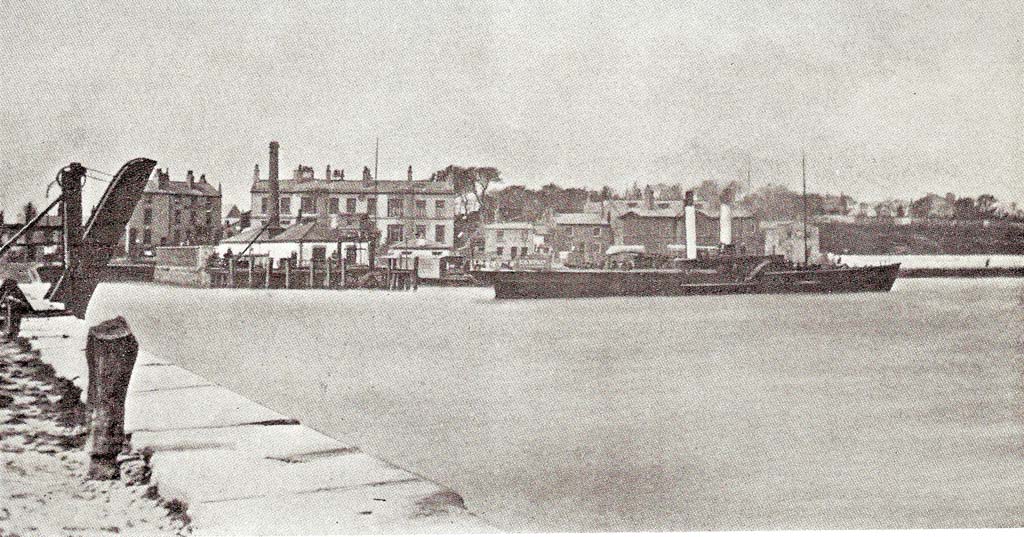 Seacombe Ferry 1876 |
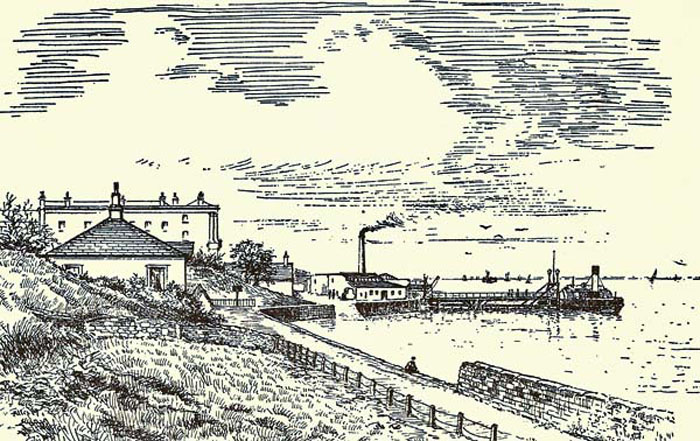 Egremont Ferry in 1878 |
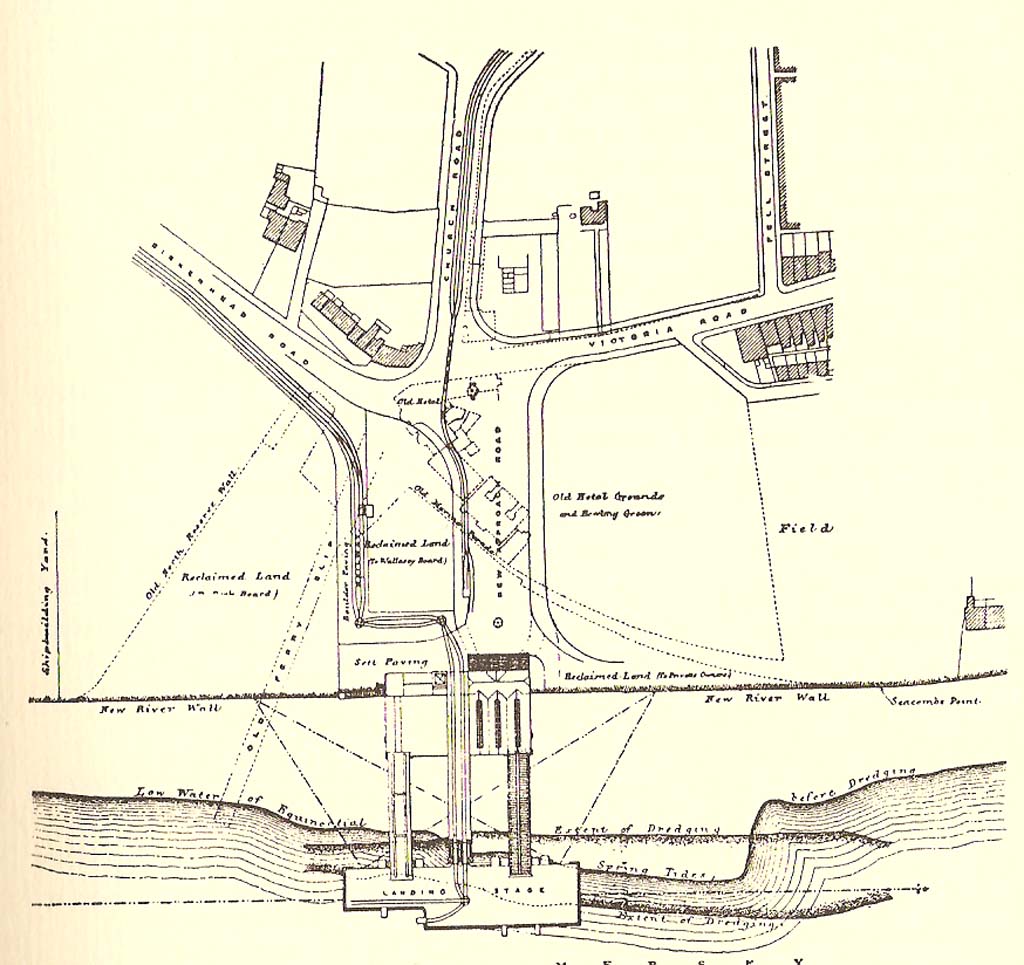 Plan of Seacombe Ferry & Approaches 1878 |
|
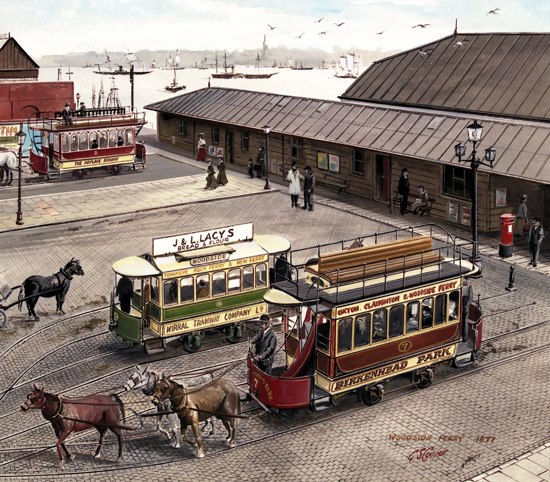 Woodside 1877. Image from Terry O'Shea |
|
|
At about 9:30 am Tuesday 26
November 1878 the Seacombe ferry boat ‘Gem‘ was
crossing to Liverpool in fog carrying 300 passengers when she ran into the
Bowfell, a Brocklebank ship anchored in mid stream. She slid across the side of
the ship and crossed her bows, where the jib boom of the Bowfell carried away
the steamer's funnel, which fell among the passengers, fatally injuring one
named Hodgkins. Several of the passengers got on board the Bowfell, but some
fell into the water, where one young man named Cannell was drowned and not found
until four hours later. The Gem landed her passengers at the cattle stage. More than a dozen people lost their lives in the incident. lf the Gem had been going full speed it is probable that she would be lying at the bottom of the river, keeping company with the five other vessels which had been sunk in the Mersey in the two weeks prior to the incident. In the discussions following this disaster, it is interesting to note that 'a tunnel under the Mersey' was seen as the best solution to end the ever increasing number of accidents. Robert Scott, a victim, lies buried in Flaybrick Cemetery, Bidston. He was 44. |
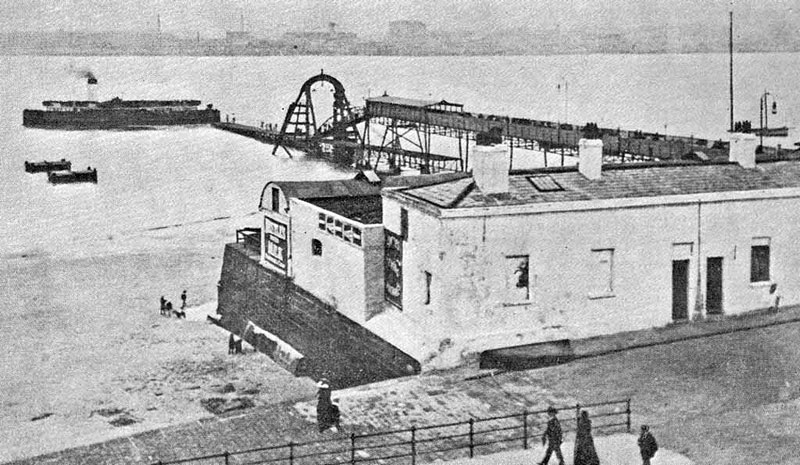 Egremont Ferry approx 1895 |
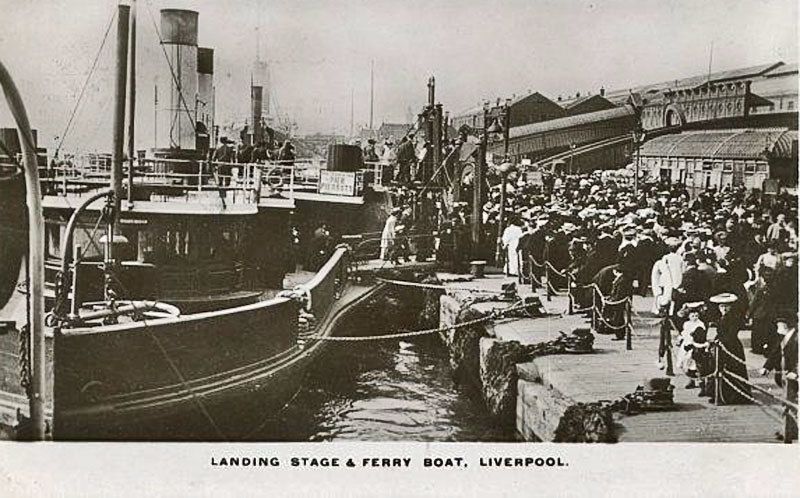 approx 1900 |
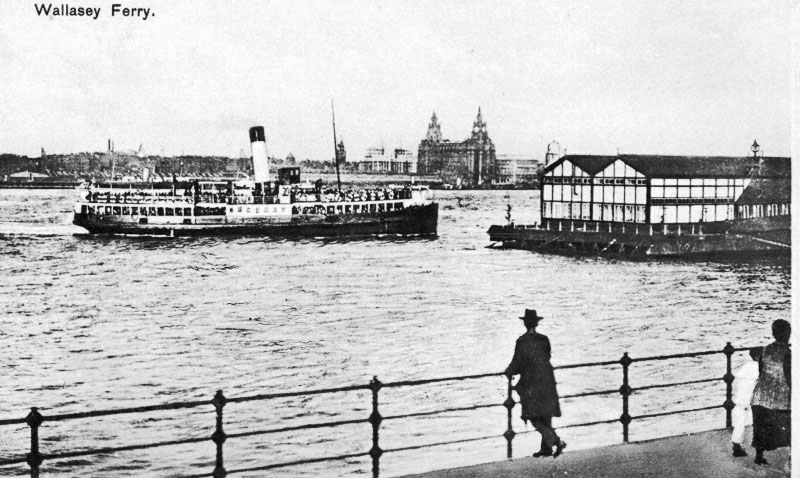 approx 1920s. |
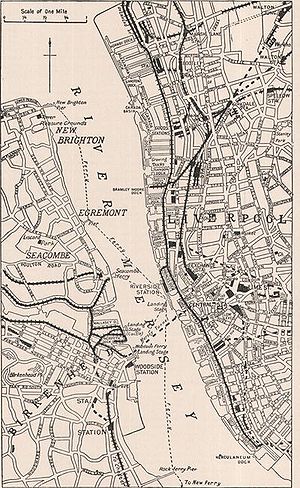 1911 Map showing Ferry Routes |
|
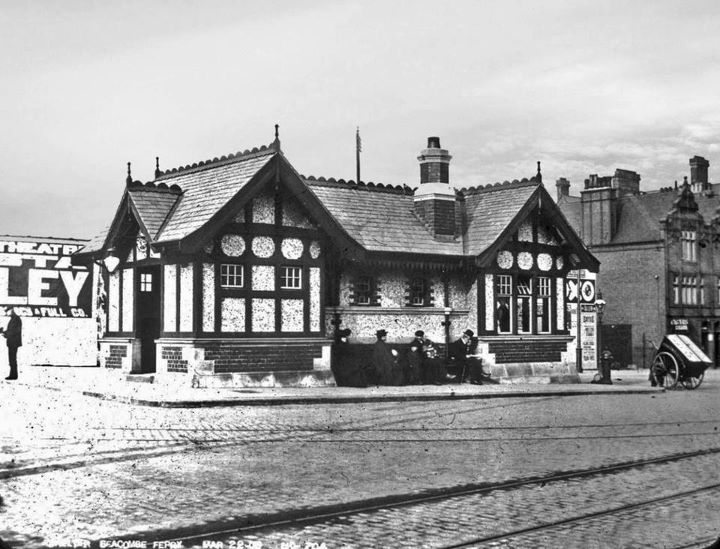 Seacombe Ferry Shelter 1905 |
In 1907, a
fierce westerly gale blew the New Brighton landing stage from its moorings,
causing the connecting bridges to fall into the water. In 1921 the old stage as
replaced.
On the 12th February 1909 the SS Ottoman rammed Seacombe landing stage. One of the gang planks was wrecked and some of the structure damaged. Until 1925 necessary repairs were all that were administered to the landing stage. In that year a larger stage and a triple track floating roadway was built, being opened by the Earl of Derby on the 23rd October 1926. |
| In 1928 traffic increased so dramatically on New Brighton ferry that this caused the Corporation to reconstruct and enlarge the end of the pier. Egremont pier was replaced in 1929. In 1932, a tanker, British Commander, broke its moorings and drifted side on, into Egremont pier, wrecking it. After repairs it reopened in 1933. The Corporation decided to refit and remodel the entire ferry frontage; the work taking 3 years beginning in 1930. and costing £93,443. I can clearly recall it as very "art deco" but I did not really appreciate as much at the time. The payment booths were, on reflection, works of art. | A spacious booking hall the roadway was divided into an "in" and an "out" circular with gardens in the centre. A covered access to the buses was provided (mine was the No 3 and No 5, dependant on the route. No 3 as I recall took a route, after Wallasey Village, of down Leasowe Road, down Twickenham Drive, through Leasowe estate, Castleway South, Birket Avenue and left onto Reeds Lane. In Moreton the No 3 went right at Moreton Cross, and along Marylands and Townmeadow Lane. No 5, via Wallasey Village, along Leasowe Road to Reed Lane, straight across Moreton Cross, left down Borrowdale Road to Blundells Drive. Whilst on this little aside, the No 7 & 8 ran from New Brighton, the 7 following the 3 after Wallasey Village and the 8 following the 5. |
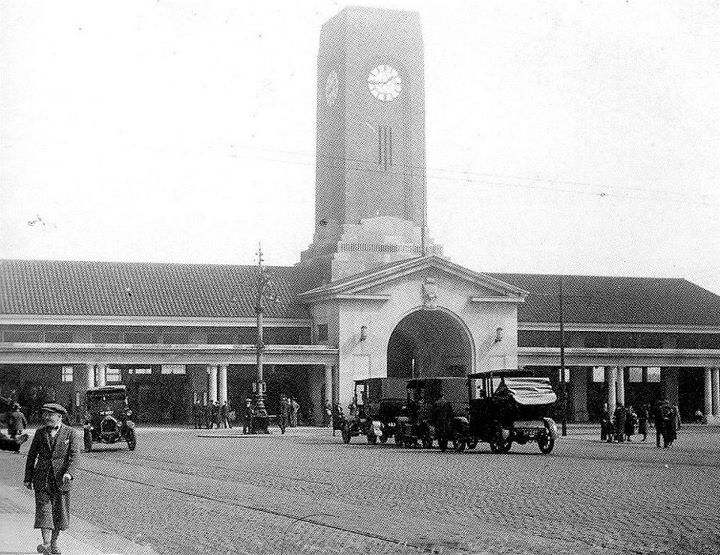 |
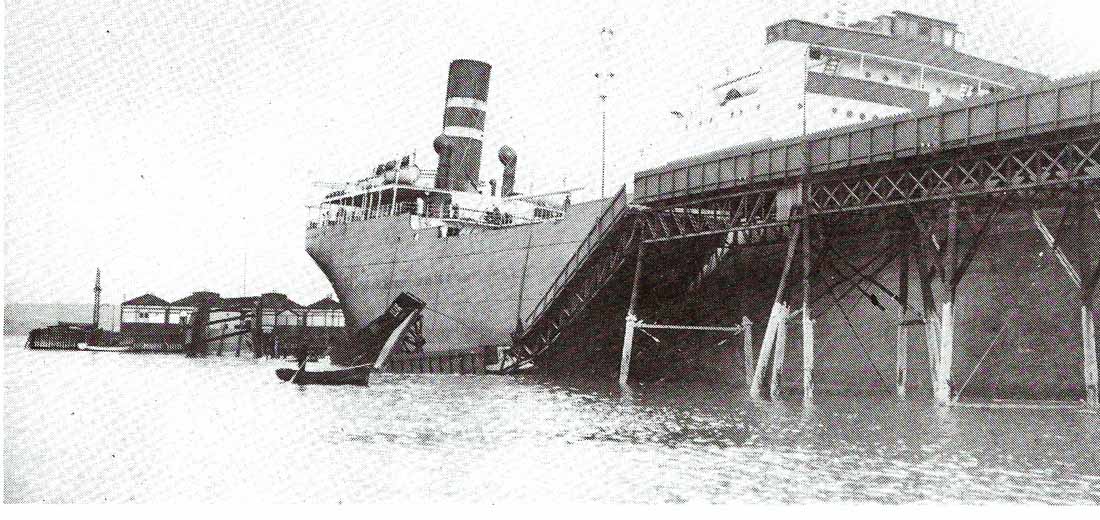
Empire Commander embedded in Egremont Ferry
Landing Stage on In May 1941, a coastal vessel, the Newlands, rammed Egremont pier and damage was so extensive it was not rebuilt. |
| A clock was incorporated into a 90 foot tower (left), an extensive council repair shop and some office accommodation. This was all opened on 10th April 1933. I can clearly recall the large deco framed windows fronting the bus stops along the left hand side as you exit the Terminal. I believe they are still in place now. Also in 1933, travelling habits of the commuters began to change with the introduction of buses instead of trams. Businessmen, particularly in the winter, preferred to get a bus to Seacombe and take the much shorter ferry trip across the Mersey. In 1936 the Corporation decided that the New Brighton ferry would now only run during the summer months. It was a wise decision as the New Brighton - Liverpool railway was completed in 1938. New Brighton ferry became the main means of transportation for holiday makers and day trippers. | |
| On 8th May 1941, Royal Daffodil was tied up at Seacombe and suffered a direct hit by a German bomb that did not explode. Although damage was not extensive, she sank at her moorings. One casualty, an engine room worker was blown out of the engine room, minus his false teeth!! It took the Mersey Docks & Harbour board 13 months to lend Wallasey heavy equipment to raise her; minus funnel and mast, but inclusive of 300 tons of mud and silt. Marine growth had, in 13 months, covered the structure. Due to other vessels being on "active service", it was decided to repair and reinstate her in the fleet. On 2nd June 1943, she re-entered service. Quite a bit of her interior decor was not replaced until much later. |
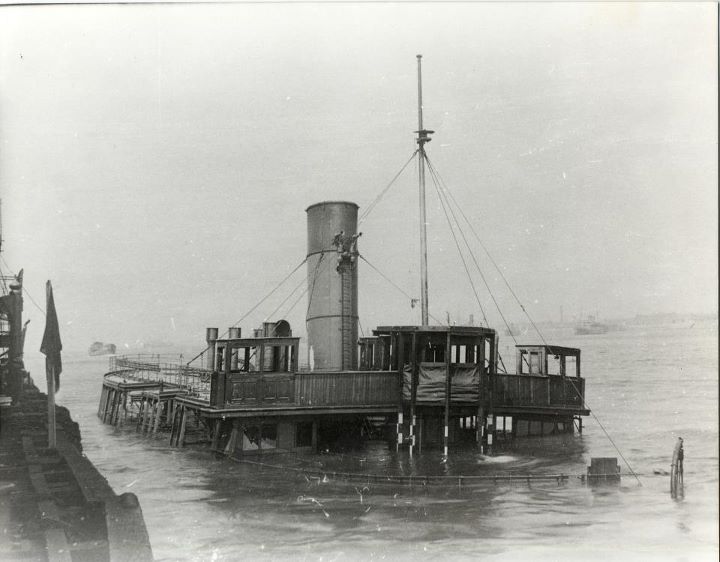 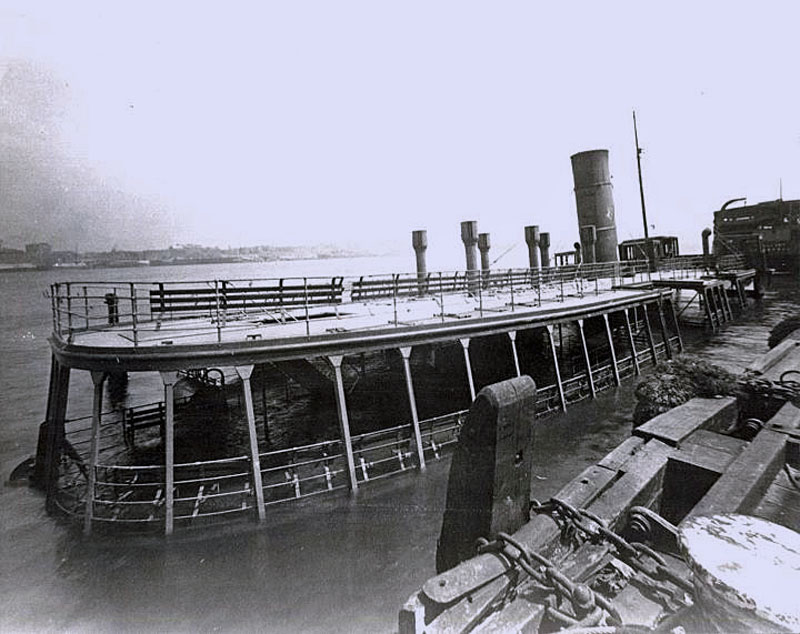 |
| In 1958 a reinforced bridgehead was installed at a cost of £12,000. Other work was carried out and the New Brighton ferry sailed on into the Swingin' 60s, closing still in the winter. The famous cruise boat, the Royal Iris, frequented the ferry during this period. And, when not taking ferry passengers, she embarked on river cruises. Another reason for the downfall of New Brighton ferry was the introduction of the car to the masses, also in the 1960s. Now a more affordable means of transportation meant that holiday makers could travel further afield than a day trip to New Brighton. They began to visit places such as North Wales and Blackpool. And further north, the Lakes. This, I believe, sounded the death knell of New Brighton as any form of resort. On my last visit to New Brighton, there were so many places "not to park" I wondered if it was actually worth any further visits. | Prior to Wallasey Corporation buying out the privately owned Ferry companies, they were haphazard and barely a timetable was met. Along with Birkenhead, Cheshire ran controlled all ferry traffic to Liverpool. From the time Wallasey Council assumed control, the Ferry has become famous the world over, particularly since the swinging sixties. Liverpool had actually very little to do with the famous "Ferry 'cross the Mersey". An undated reference to early ferries remarked that the ferry was not running because it was out towing, passengers being kept waiting for hours. On occasion, passengers would be stranded in Liverpool, no boat crossing to collect them. Their answer was unfortunate and time costly. They had to take the Birkenhead Ferry to Woodside, walk along the Wallasey Pool, on the wrong side to near Bidston, around to Poulton, and home, a distance of many hours! I have read of early references of local ferry traffic crossing the Pool, maybe it was not in existence at this undated time? It was also not uncommon for passengers to receive a thorough soaking by falling from planking placed between boat and sand. |
| In 1963, Ernie Read, who worked on the Seacombe Ferries, died. He was the recipient of a Certificate from the Humane Society in 1939. At present I do not know what this was for. My thanks to Peggy, his daughter, for this information. | |
| At no time was Liverpool involved in the Mersey Ferries; all the boats being owned and operated by "our side" of the river. In my lifetime, Woodside boats were Birkenhead Corporation, Seacombe & New Brighton, were Wallasey Corporation. Now, in this 21st century, Mersey Ferries runs a very streamlined cut down service where one solitary boat covers Woodside - Liverpool - Seacombe - Woodside. And a bit of a con job here too. The last time I used the Woodside Terminal (Aug 2008), they charged me & my daughter "tour price" of some £7+ as it was after 0930. The boat is supposed to tour the river before depositing its passengers at either of the three stops. My boat ran straight to Liverpool and no tour!! Robbed! Now I park in Bhead and use the train. |
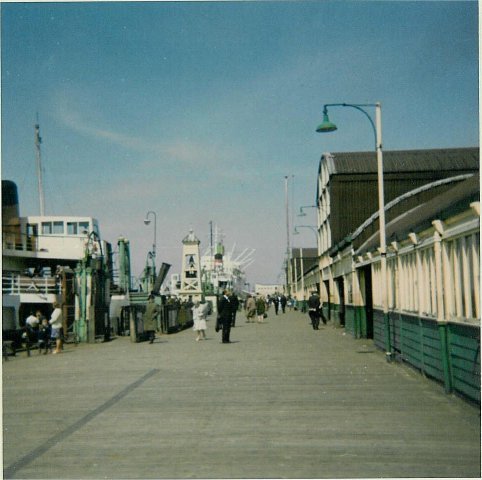 Princes Landing Stage Liverpool late 60s |
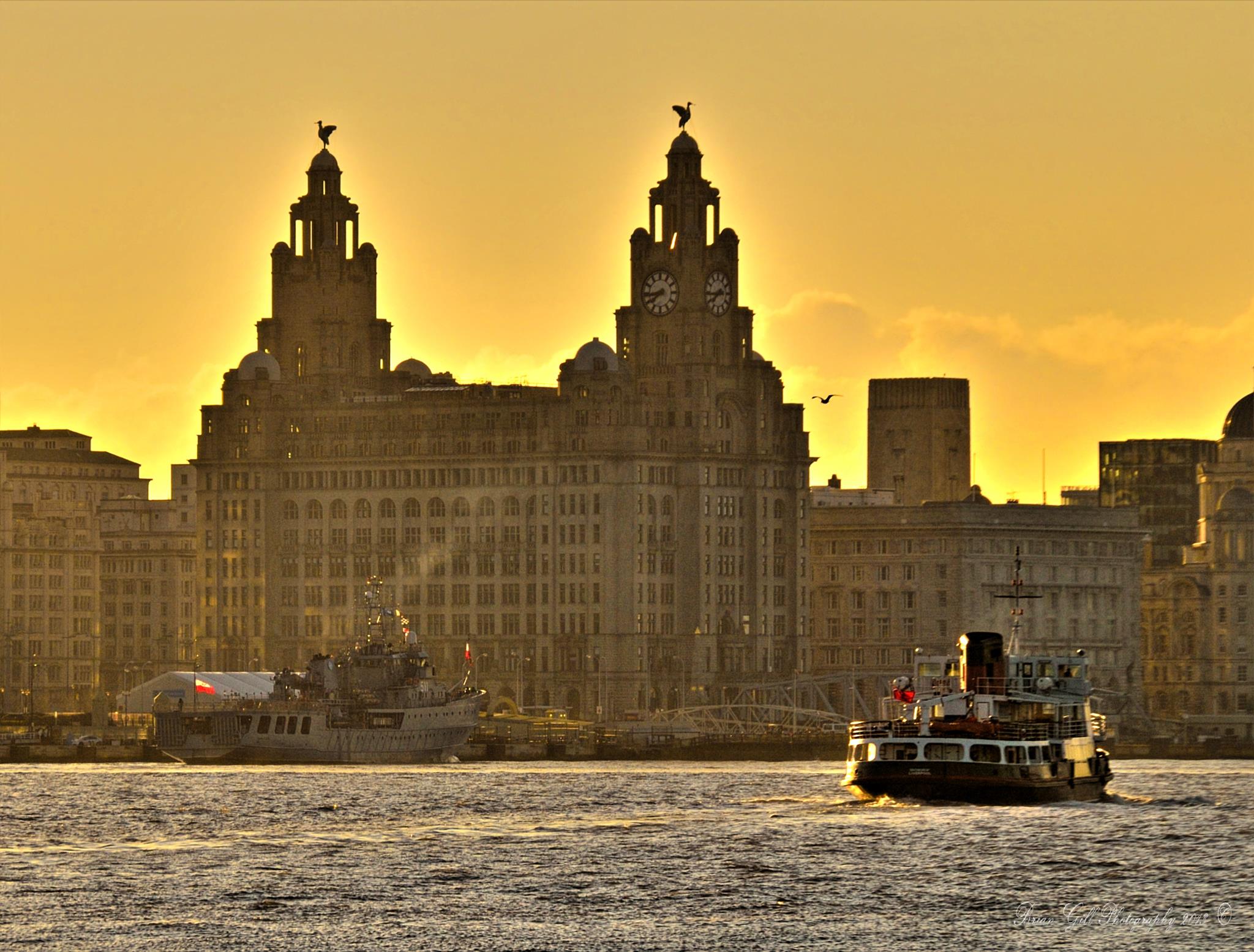 This excellent image was taken by Brian Gill in April 2013. The warship is Polish Navy. |
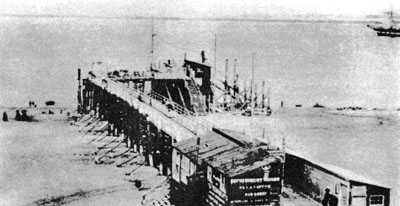 New Brighton Ferry 1840s |
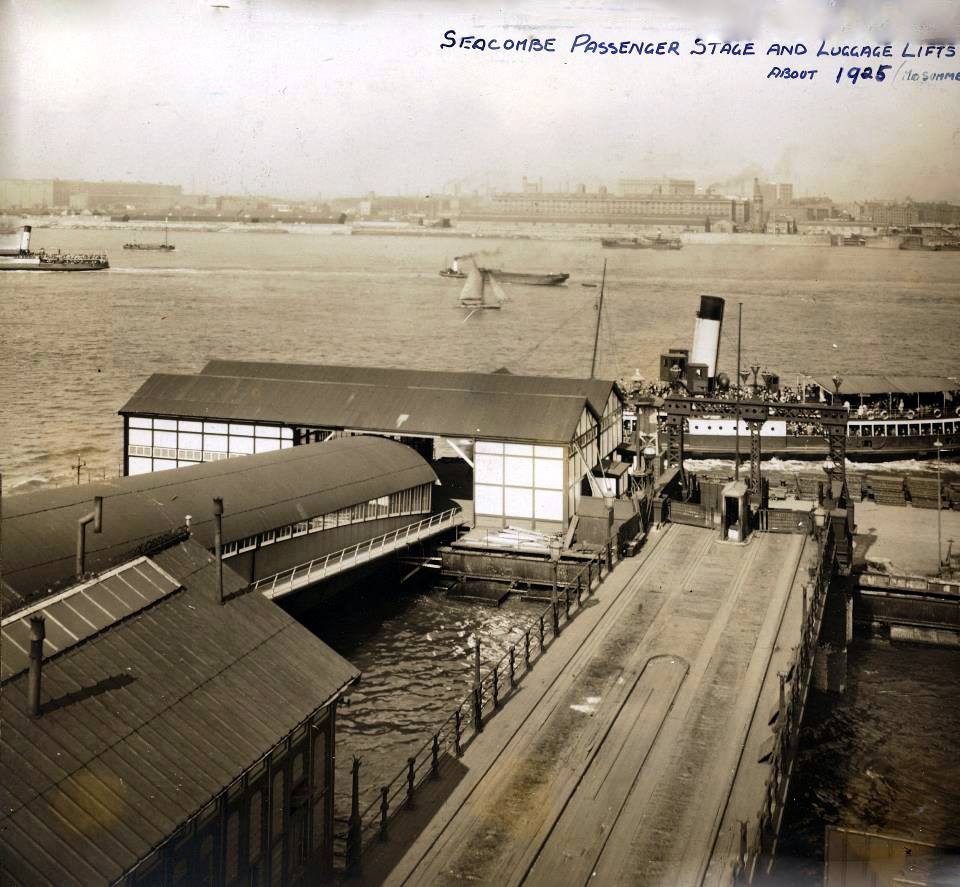 Seacombe Ferry Passenger stage left and Luggage on the Right |
|
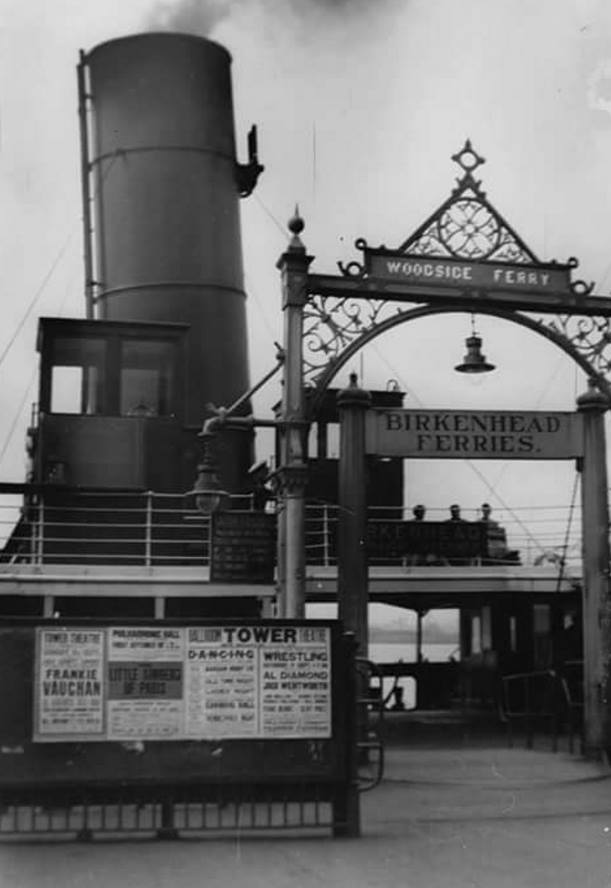 Woodside |
|
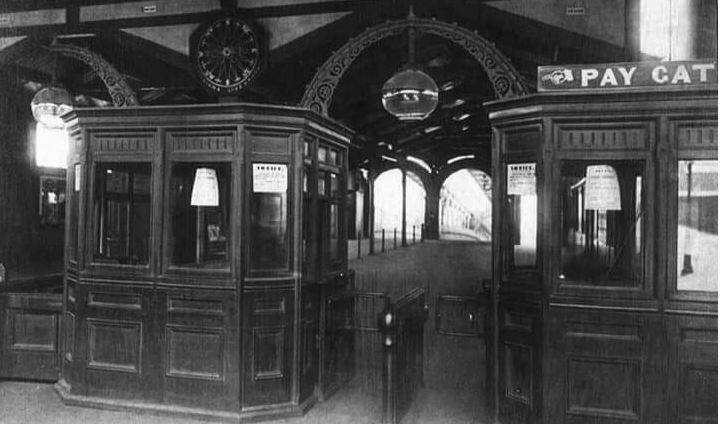 Above and Below Woodside Ferry Booths (Andrew Barr) |
|
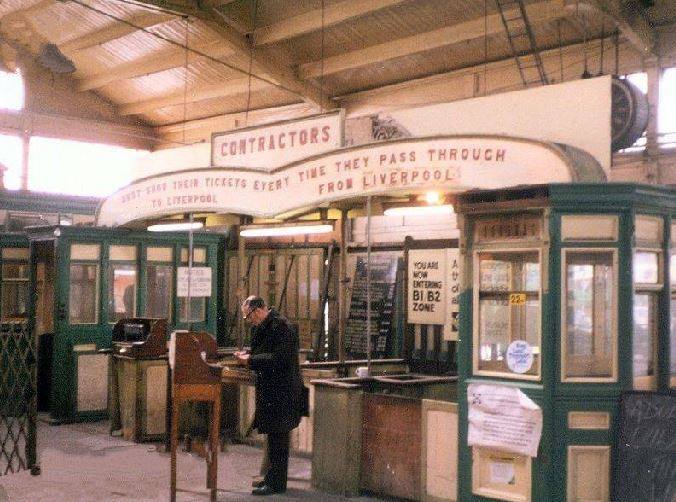 Image copyright Brian Tuohey |
|
| Miscellaneous Images of Ferries & Terminals | |
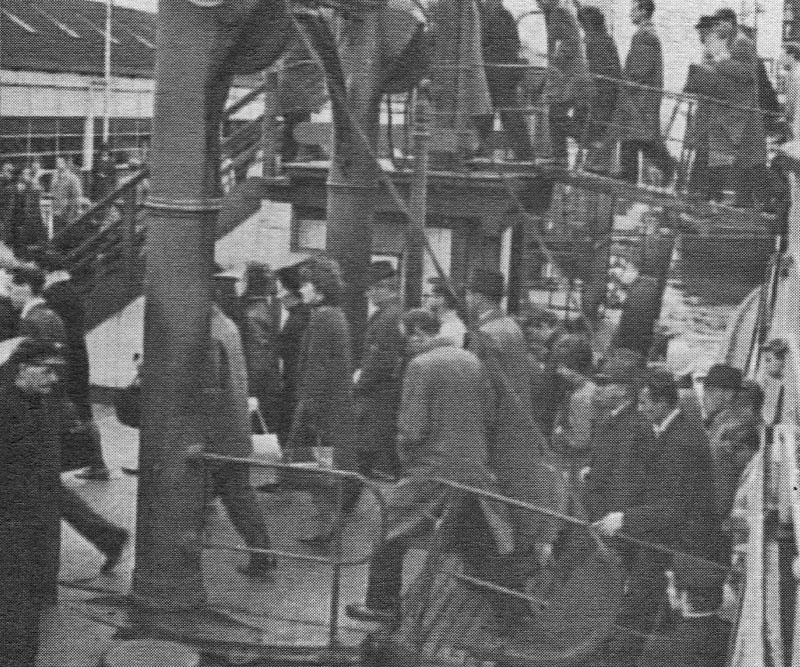 Passenger disembmark at Landing Stage from Daffodil. |
|
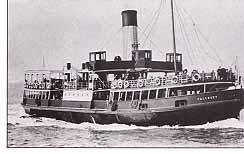 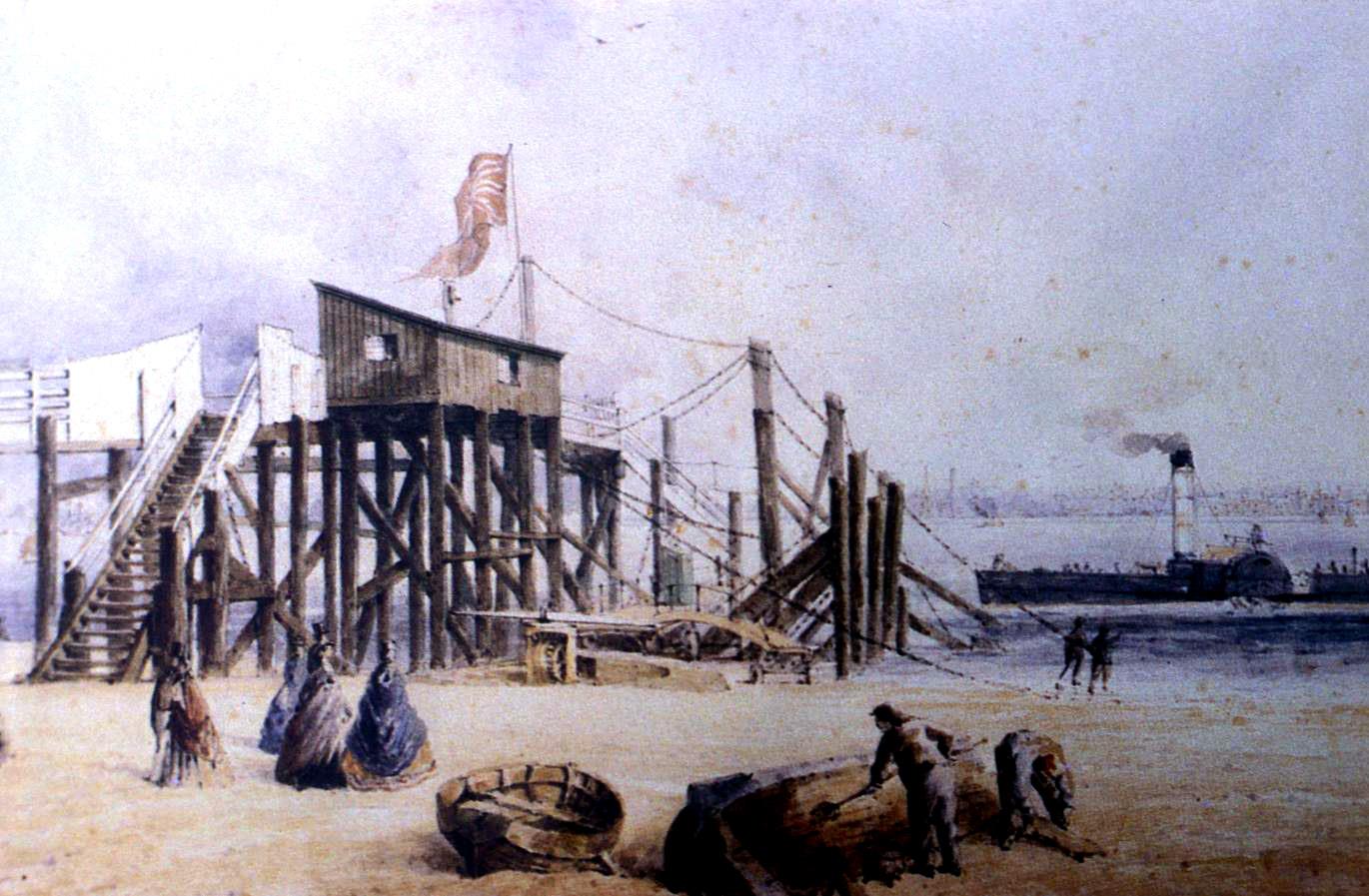 Original New Brighton Ferry Undated image of the ferry 'Wallasey' |
|
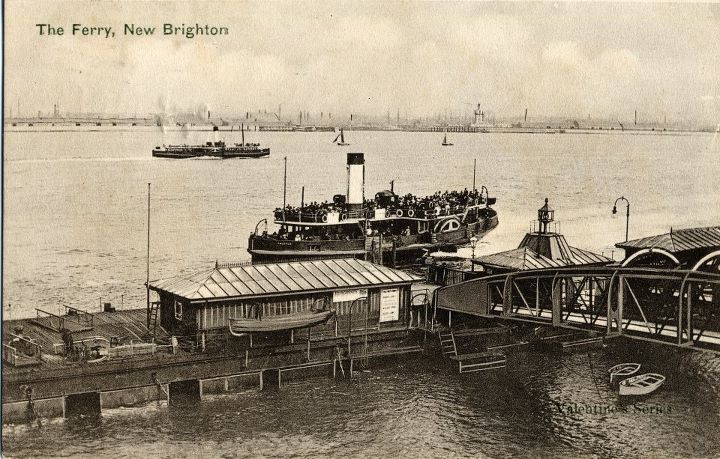 |
|
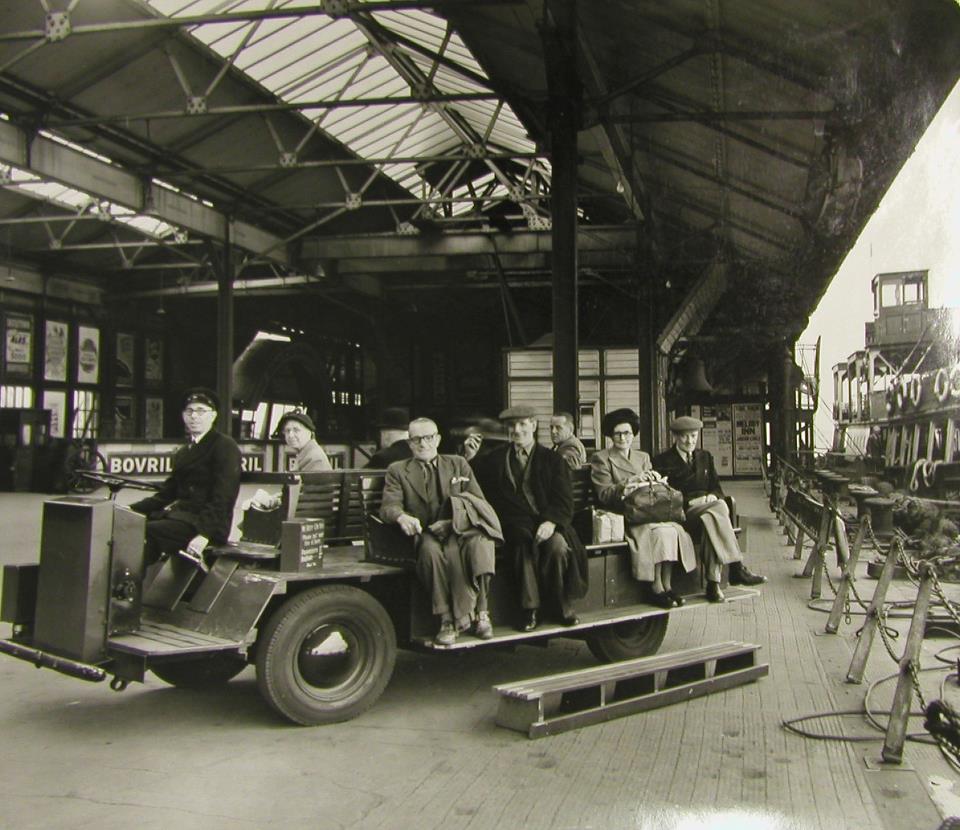 Date unknown, but judging by the Ferry, its 30s or 40s. I can remember this was still a ferry function in the 1960s. I saw it and rode it |
|
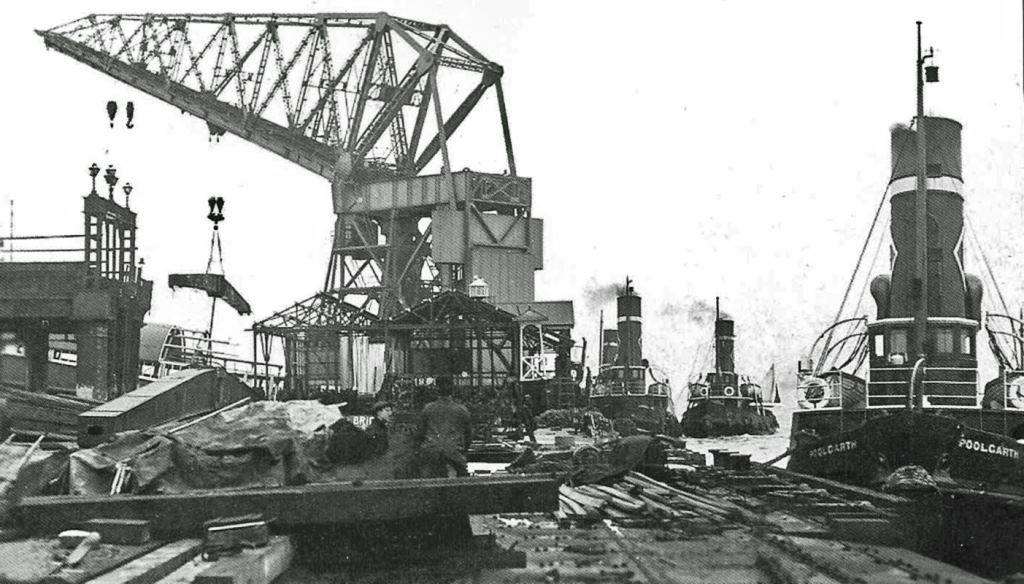 Mammoth working on Seacombe Ferry. This will be pre war as the Poolgarth (right) was sunk in WW2 by a mine in the river off Canada Dock. |
|
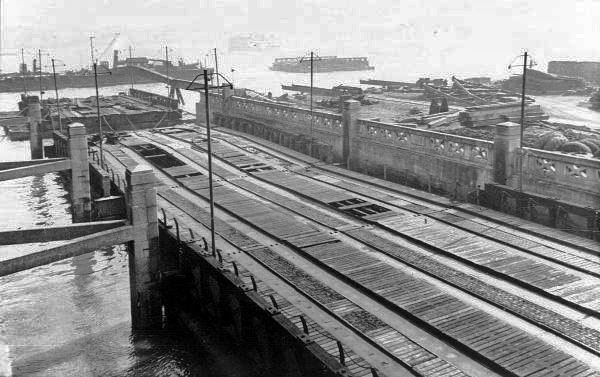 Seacombe Ferry floating roadway, used to take luggage etc onto the luggage boats. Looks like a construction phase photo, note section in river. |
|
|
|
|
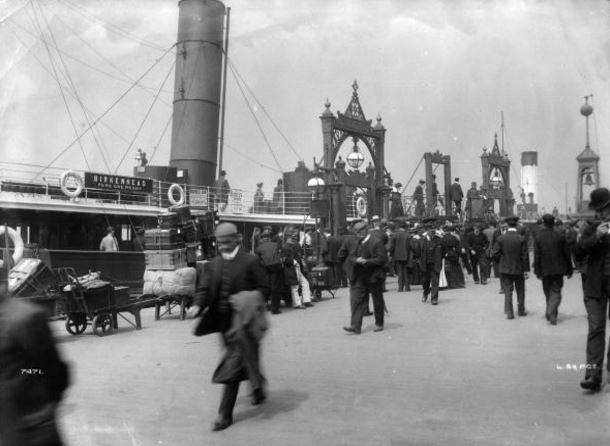 |
|
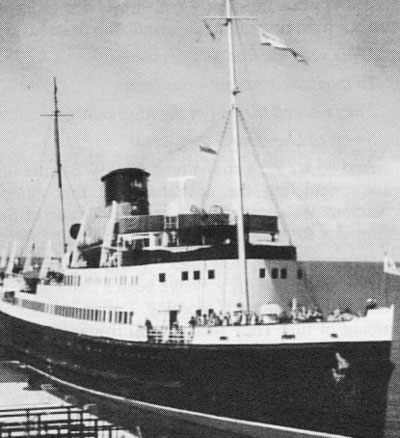 |
As it operated from the Mersey, to Llandudno, The St Tudno could be
counted as a 'mersey ferry'. Launched in 1926 at Govan shipyards,
she sailed until 1963 when she went to Ghent, arriving 19th Apr 1963,
to be broken up. 318 feet long and 44 feet wide. She belonged to the
Liverpool & North Wales Steamship Co. Between 1939 and 1947 she was
requisitioned by the Government as a depot ship. There were 2 St Tudno's. The first sailed from 1891 - 1912. |
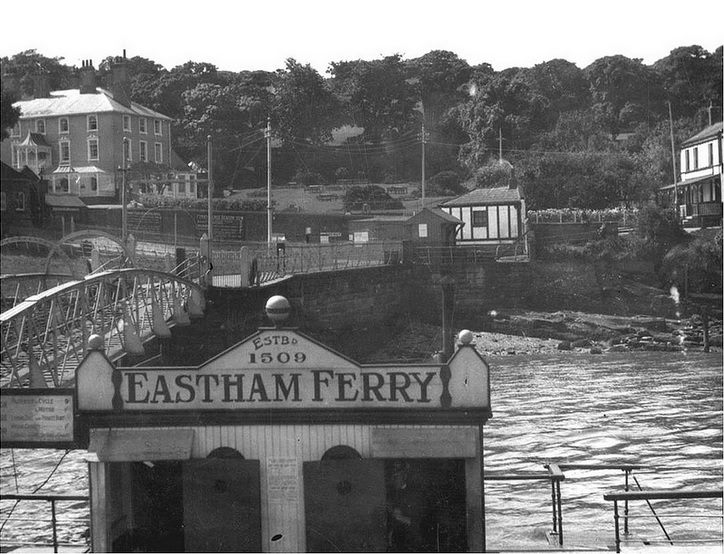 |
|
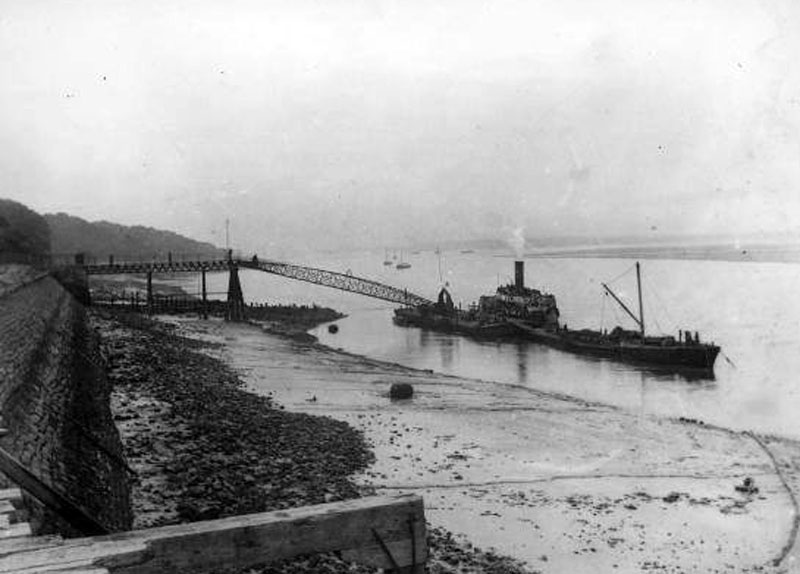 |
|
| Job's ferry & Eastham Ferry | |
| Egremont Then and Now | |
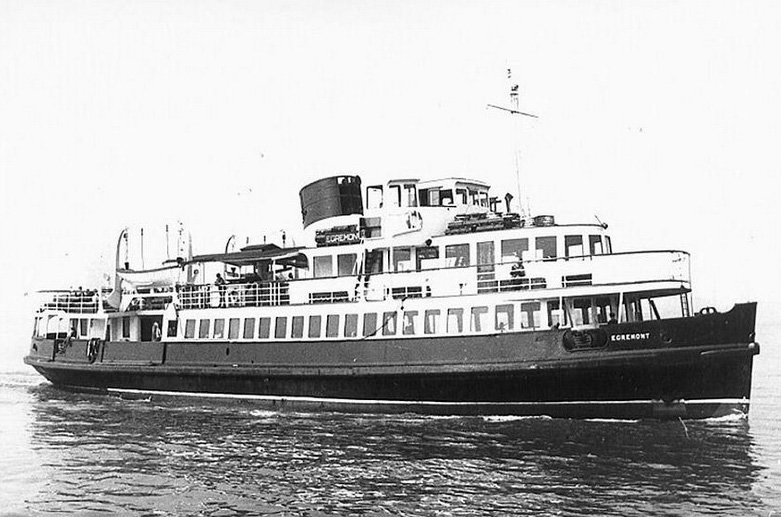 |
|
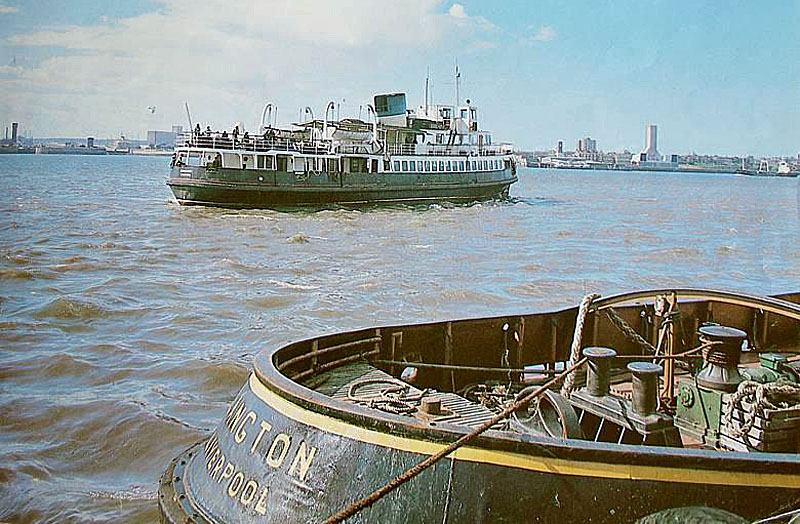 Egremont on the river. The Tug is the Langton |
|
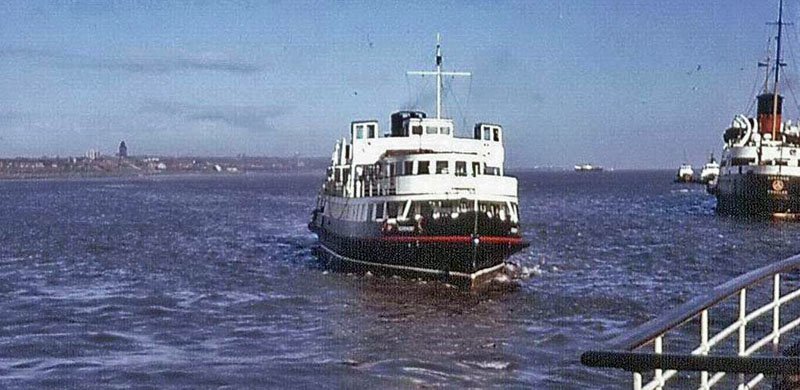 |
|
|
In her new home at Salcombe |
|
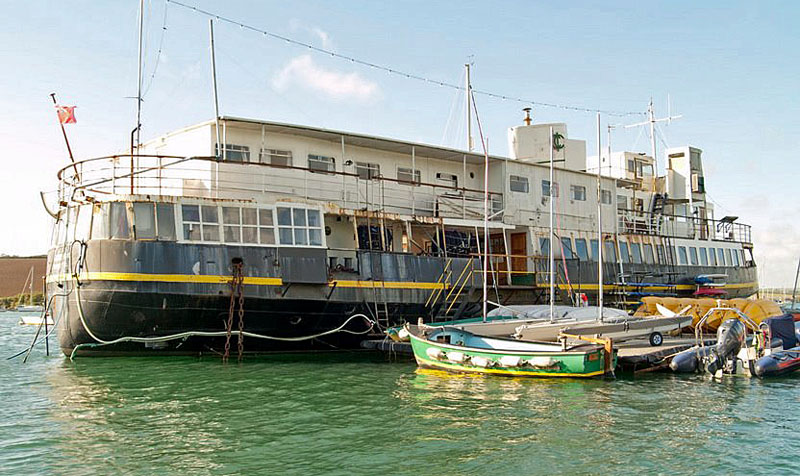 Beginning to look a bit rusty!! |
|
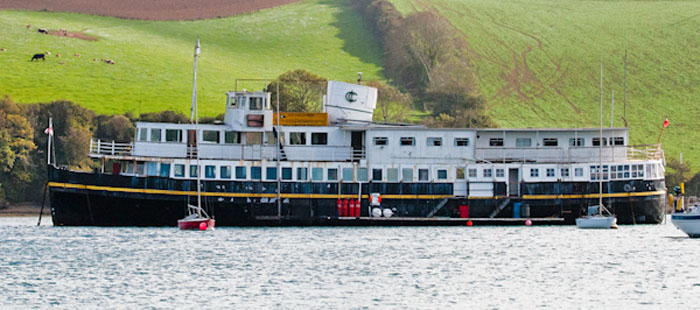 |
|
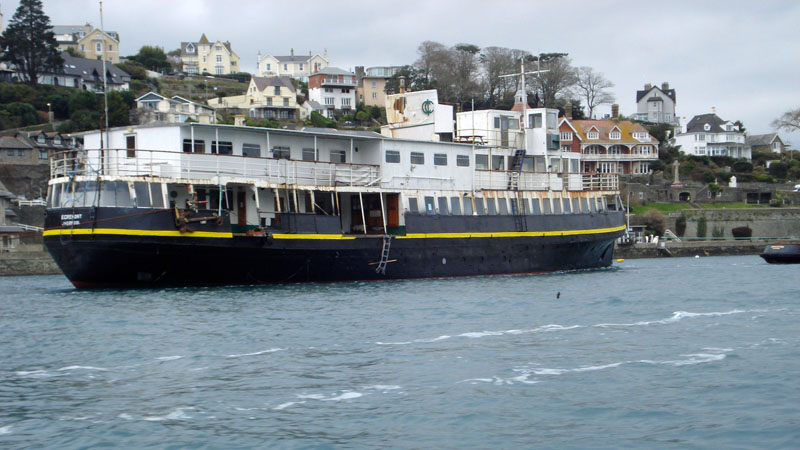 |
|
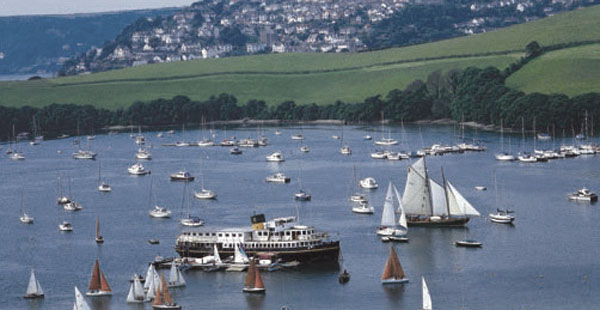 |
|
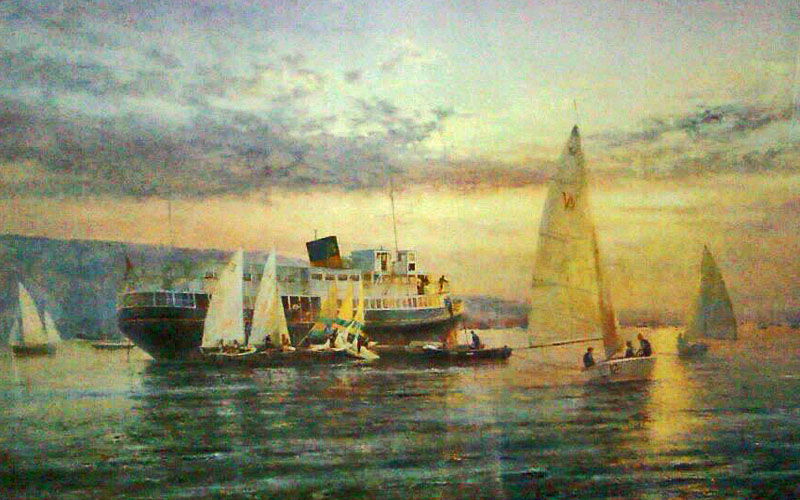 |
|
| Daffoldil | |
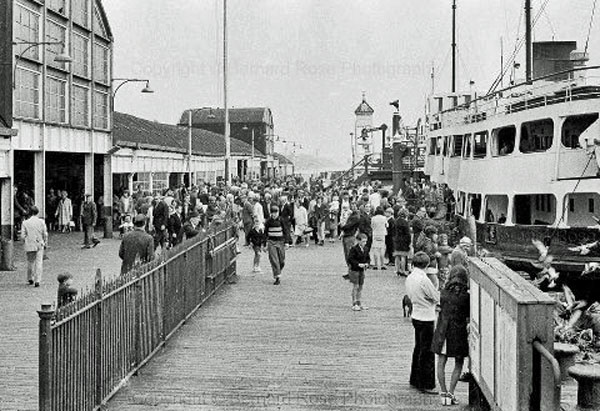 Daffodil at Pier Head |
|
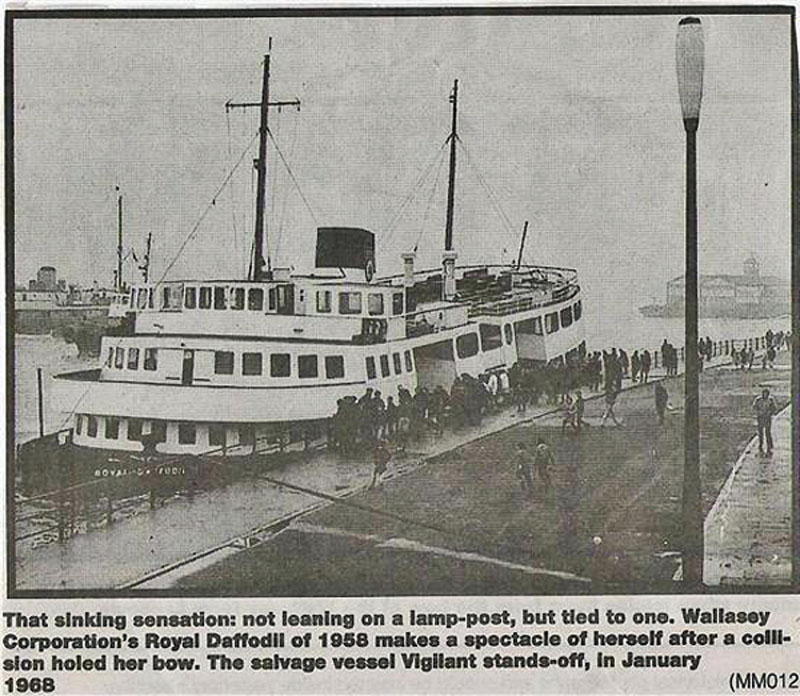 |
|
 |
|
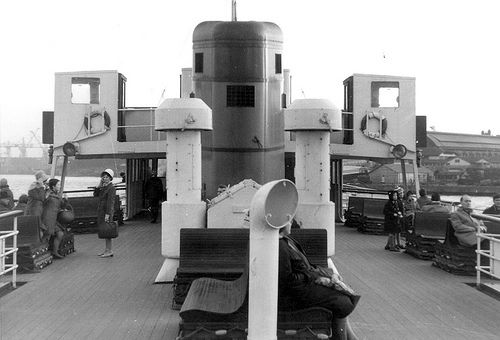 Brand new Mountwood or Woodchurch arriving at Woodside date about 63-64. Woodside Railway station can be seen behind the ferry terminal and Cammel Lairds shipyards to the left |
|
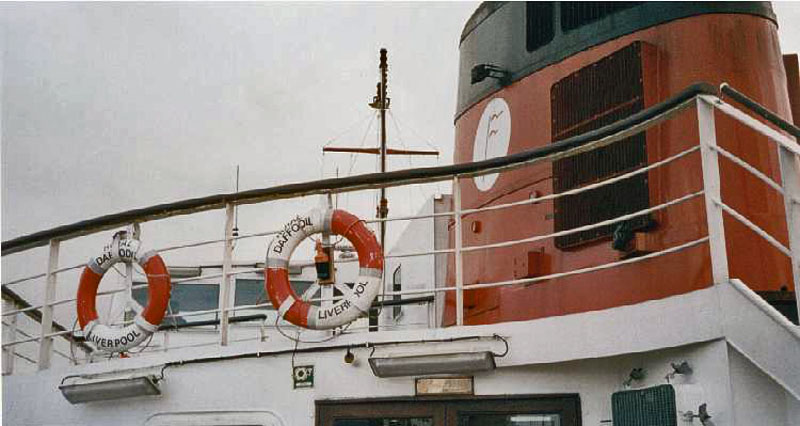 |
|
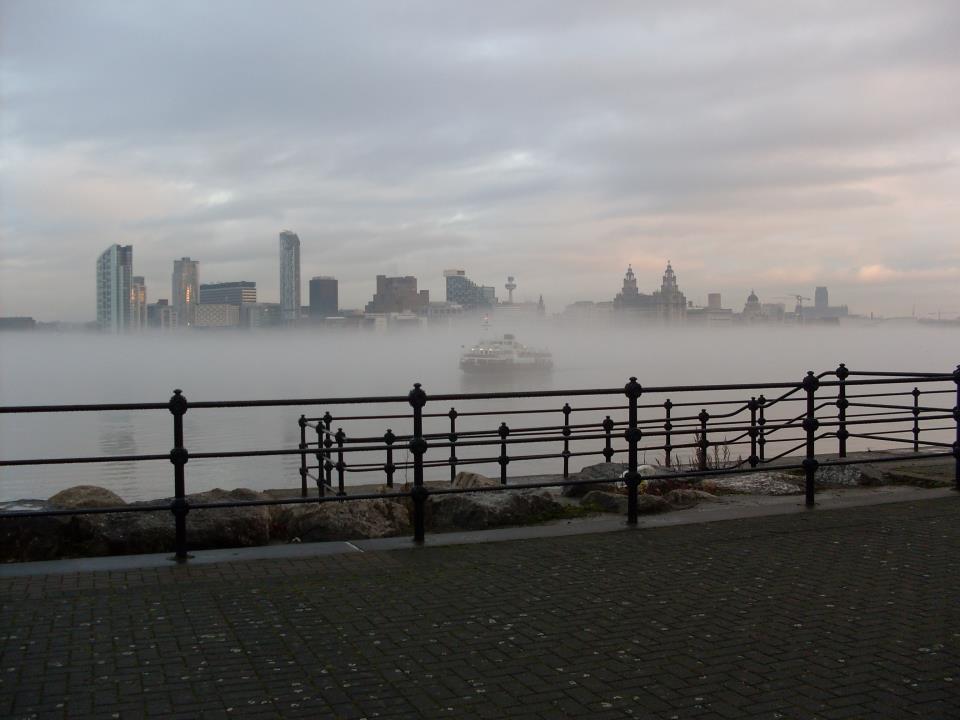 This is another image from the Ferries memorabilia page on Face book. Image I believe: David Langton |
|
|
May 2015 |
|
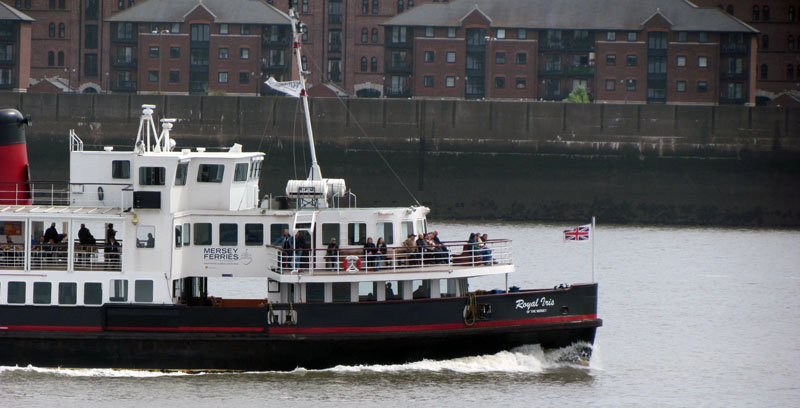 |
|
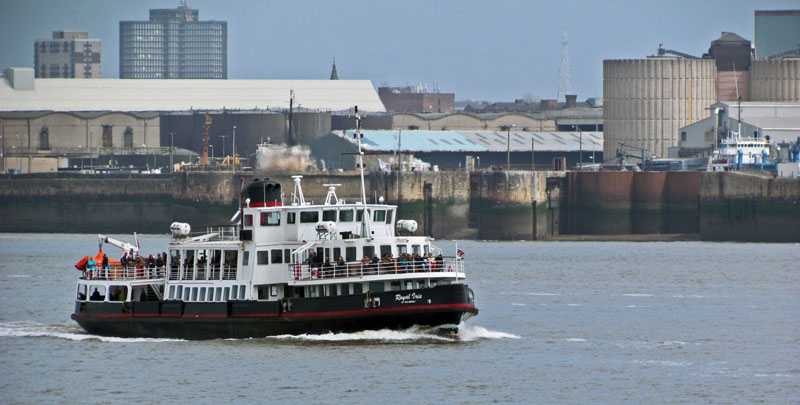 |
|
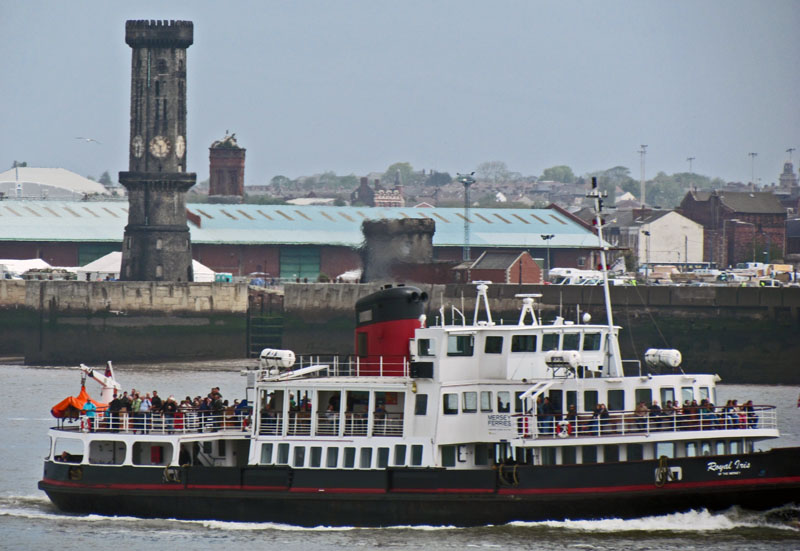 |
|
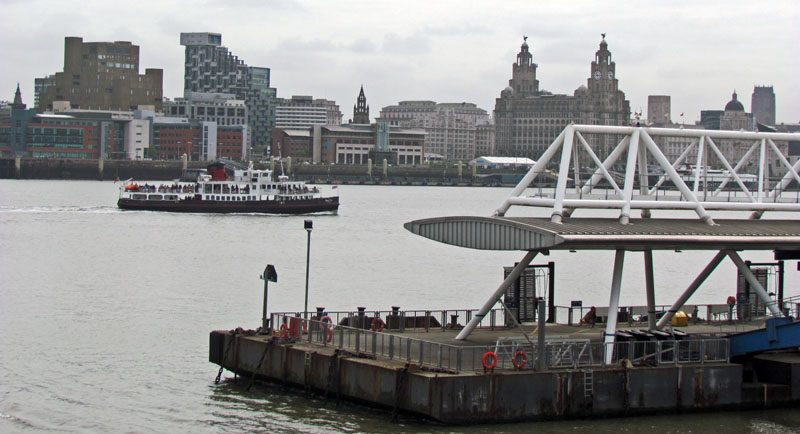 |
|
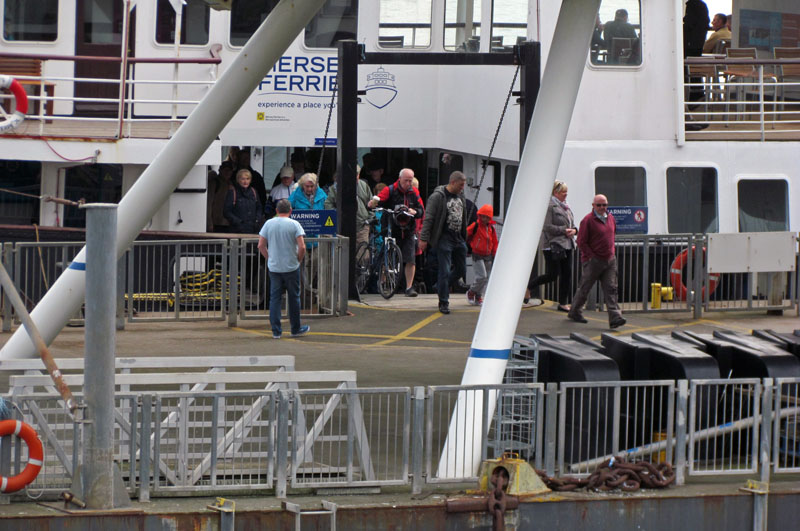 |
|
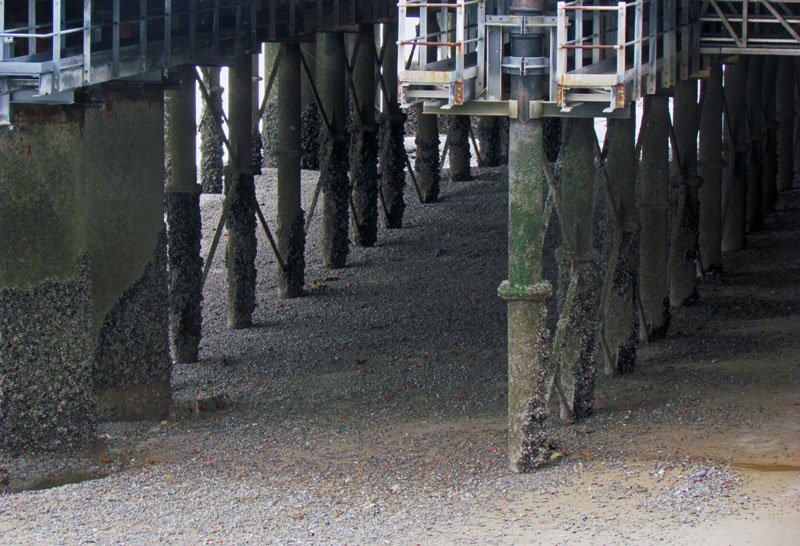 |
|
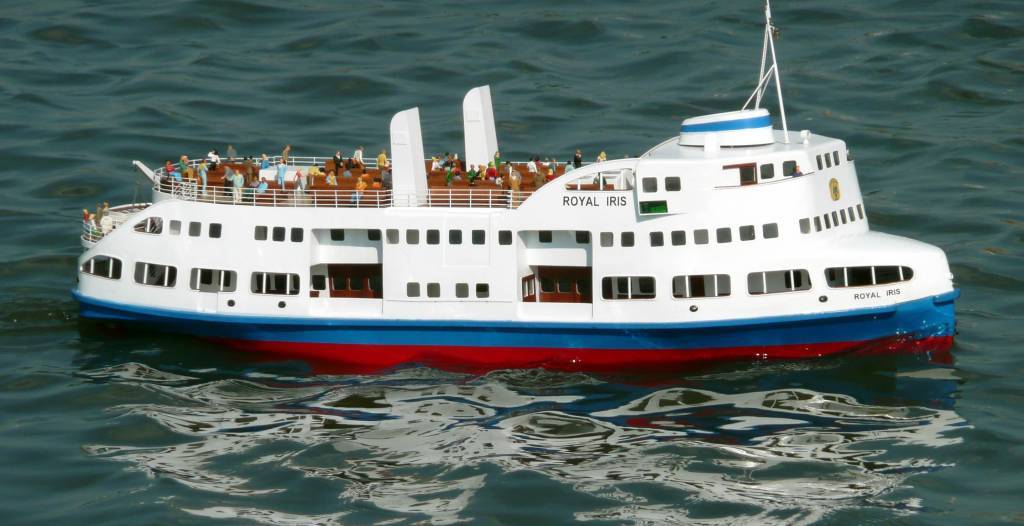 This photo of the model of the Royal Iris in, as I recall, MPTE colours, was taken on New Brighton Boating Pool in June 2009 |
|
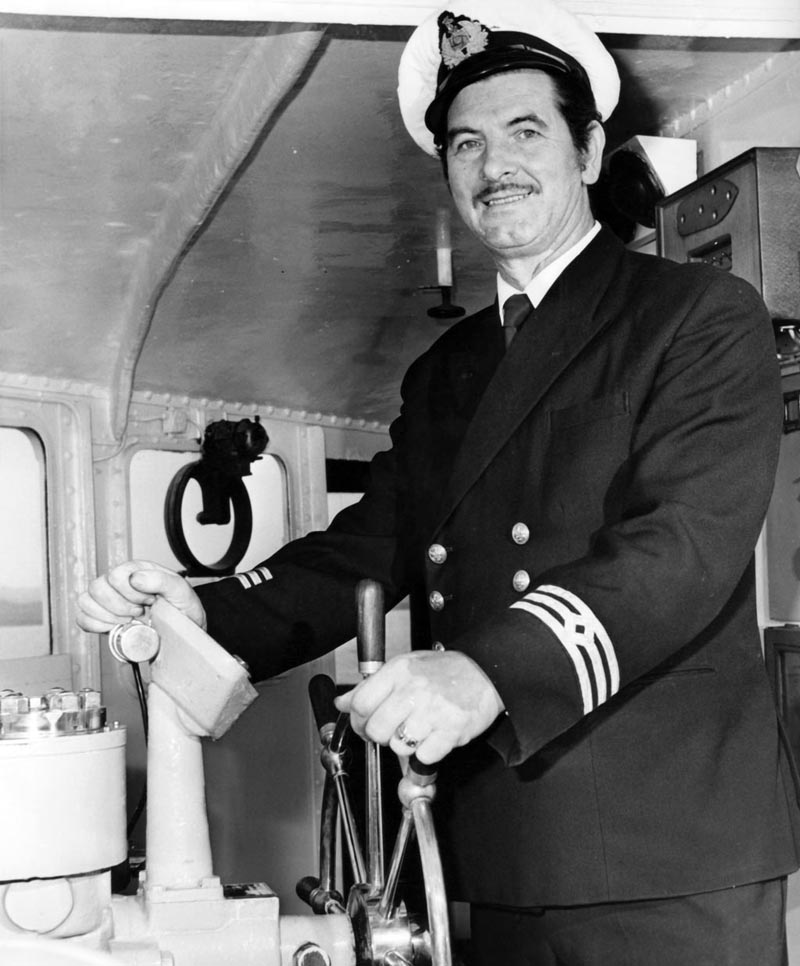 Captain McWilliams. Captained both the Royal Daffodil II and the Royal Iris. Image from his grandson Paul. As soon as I saw this image I thought, 'I remember him'! |
|
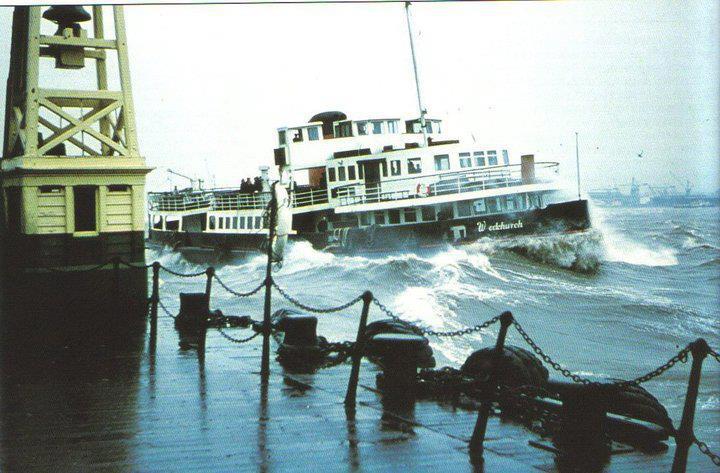 Woodchurch in heavy weather |
|
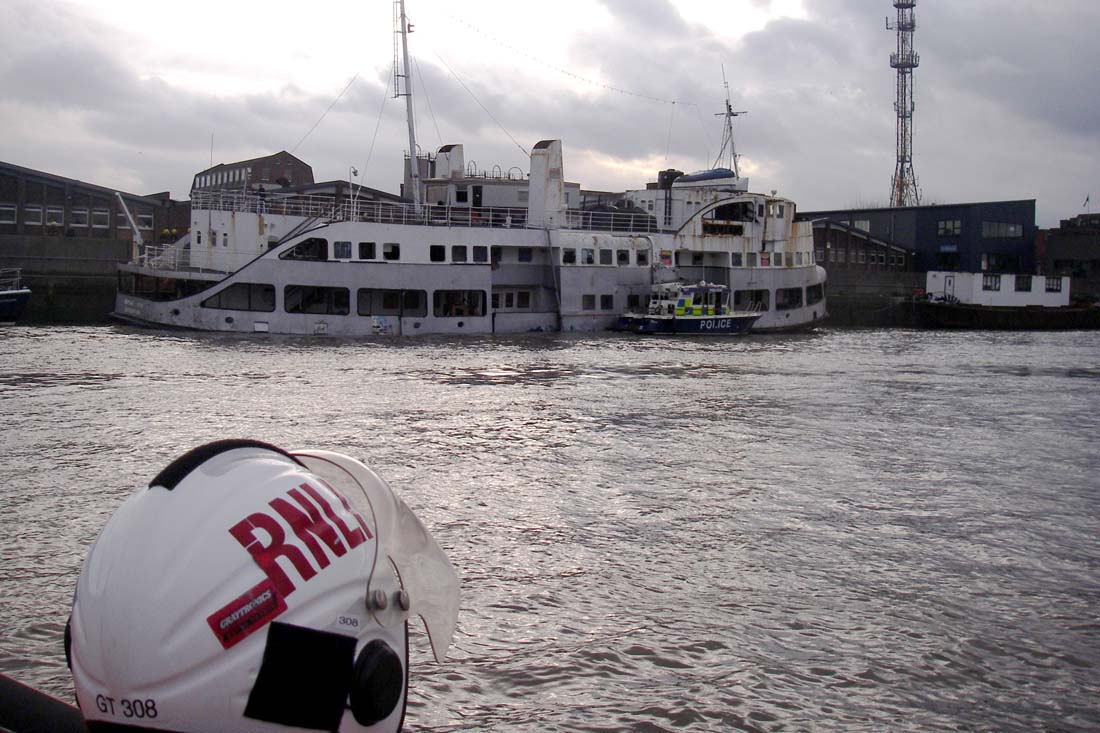 A recent photo, sadly she will be scrap soon. Is this not fly tipping on a grand scale? According to reports, she is moored on a private wharf so nothing can be done |
|
| The ageing Royal Iris, the last ex-Wallasey vessel, was considered surplus to requirements. (Or in Council parlance - what's she worth?) She was sold in 1993 to a consortium for conversion into a floating nightclub, based in Cardiff. This venture ultimately did not come to fruition. Since 2002 the vessel has been laid up on the River Thames awaiting a 'possible' refit as a floating nightclub. http://en.wikipedia.org/wiki/MV_Royal_Iris 2011. Now, as we all know, the Royal Iris is not even a 'floating' hulk, being sunk on the bed of the River Thames with a hole in her side. To convert or save her now would cost far too much money. | |
| The Mersey Ferry That Was NOT | |
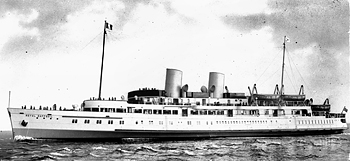 |
|
|
I am somewhat confused by the above image and the one that operated
on the Medway. The above ship is far too big to have been a 'local'
ferry. It appears to be a 'royal - something'????
Below: This is the Royal Daffodil whilst on service in Kent from 1934 - 1938 and supposedly used at Dunkirk. It did serve on the Mersey for a while. Thanks to Peter for that info. |
|
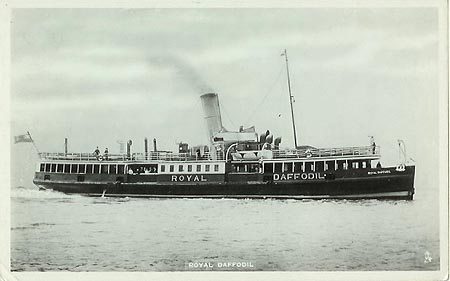 Imperial War Museum Photo |
|
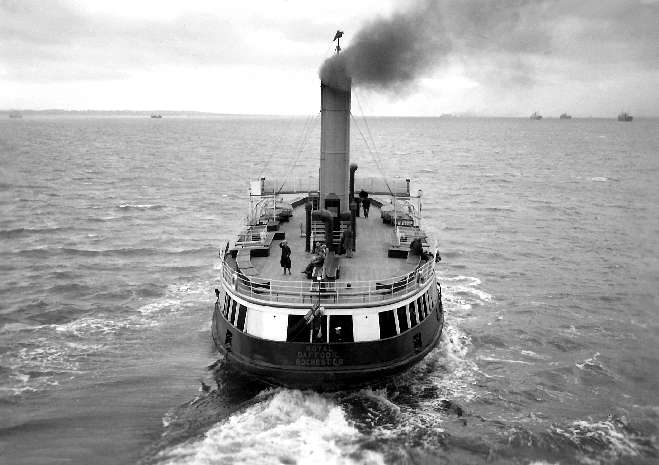 |
|
| What happened was the Daffodil was sold to Kent in 1934 and lasted till 1938. The Daffodil of 1939 onwards, and used at Dunkirk was supposedly the twin funneled one pictured above. When Daffodil was replaced on the Mersey by the new one, the BoT refused to allow it to be named Royal Daffodil because there was already this boat by that name so Wallasey Corporation named their new one Royal Daffodil II. | |
|
Modern ferry names (As at 2010) and their previous: Royal Daffodil - ex Overchurch |
|
| http://www.canalscape.net/Diarama%20Website/Wyre%20Heal%20eBook/13%20-%20Mersey%20Ferries/13-Mersey%20Ferries.htm | |
Email - November 25th 2009: My family, Palmer Brothers in Cork bought the Royal Iris ( of Zeebrugge fame) and the Lily and Rose and used them as tenders to the liners when they called to Cork Harbour. The Rose and Lily were renamed Failte ( Irish for welcome) and An Saorstat ( the Freestate) . Is there any record of which was which, this is a question sent to me recently? Family records are pretty meagre and all of the crews and principals of the family have gone to their rest. The Royal Iris name was retained and my family returned a plaque which commemorated the activity at Zeebrugge to Liverpool . Is there any trace of this plaque in Liverpool? Any links to further history of these ships would be very welcome. R Palmer. You can email R Palmer directly at: rfpalmer - at - ukonline.co.uk can you also copy any info to me please?
Chris Neil emailed me in Jan 2010: My great grandfather James Macfarlane who shows on the 1911 census living at 17 Hawthorn Grove and working aged 54 on the " Ferries Council". He probably worked from Seacombe given where he lived.
|
1. WW2 Thunderbolt. (Moreton) |
|
|
2. U Boat 534 |
|
|
4. Hovercraft |
|
7. Mother Redcap's |
Sources:
Most of these images are my own property but some came from these and some are just links:
My thanks to the members of
the Mersey Ferry Group on Facebook: David Langton, Brothers Grin, Jeanette Land,
David Garbutt, Andrew Barr, Robbie Quinn, Brian Gill, Robert Hayden Foy, Mersey Ferries.
David Langton actually does talks on the Ferries. I saw him in October 2012 in
the Floral Pavilion in New Brighton doing such a talk. Well worth a visit. David is a former skipper on the Ferries.
http://www.liverpoolpictorial.co.uk/
http://www.liverpoolmuseums.org.uk
http://www.hslc.org.uk/ The Historic Society of Lancashire & Cheshire